#i really need to actually DRAW them more so I have more accurate icons
Explore tagged Tumblr posts
Text
Oh look it's another GD crossover
Ghost Drone AU - @electrozeistyking
You already saw all this art but shhh HAPPY BIRTHDAY.
This originally started out with me just wanting to draw Beanie interacting with the Intertwined Codes Kids but then I added some extra stuff lol.
If you're a reader of Intertwined Codes, this kinda sorta spoils future stuff bc only the twins have been mentioned in the Draft/Teaser fic but oh well. You have been warned.

IC!Uzi wouldn't like actually meet GD!N bc they'd kinda decide that "hey, let's not have the widowed man see an alternate version of his wife that actually got live." simply out of respect kinda?? So she would stick around at home with the kids whilst IC!N goes out to look for Beanies Dad after their kids drag her to them lmao.
So yeah she doesn't necessarily know the extent of the mans depression, the kids just mentioned there only being a dad so she just specifically asks about GD!N in this doodle

IC!N would quickly pick up on GD!N not being completely okay, even without being told any details. So he probably would end up sitting him down to talk on their way back to the IC!Doorman families place, wanting to help if he can in any way. (He runs a Daycare and tries to also be a support to any parent that needs it, so I feel he out of habit would lean into trying to do that with GD!N)
More/The kids under the Cut otherwise the post looks so long rip


I will go over each of these one by one (can'tdo close ups bc 10 image limit, I'll reblog this in a second with the close ups.)
Left are the Code-Related Nuzi kids, right are the adopted ones.
Code related kids
Zagi:
Not much to say, I'm still working out their personality - they're maybe 2-3 years older than Beanie, so they aren't too far apart in age. :)
Orita:
She's the sibling who started the trend of putting stickers on her siblings, so she DEFINITELY would do the same with Beanie.
She also probably originally was going to show her how to build a weapon, but her parents promptly stopped that lmao .
She would think it's really cool that Beanie has a custom core icon & in general is completely customized from the start! She herself was originally put into a regular worker body (just with the tail and headband being custom made by her mom), she had to build the DD forearms herself. She also has a sticker of the DD icon on her core, covering the WD icon :3
Rexim:
At this point he has enough siblings to be past the "ew a little kid" phase, so luckily Beanie gets spared that. His main camera is damaged, he only really uses his headband optics to look around, so he would kinda just look as if he's staring past her a lot. But bc of the obvious cracks in his visor I feel she would pick up on the fact he's not actually ignoring her.
Also he definitely would just play music to her, because IC!Uzi kinda always has music on whilst working in her workspace he kinda picked up some of her taste in music (Hence he's playing the same song that Uzi is shown to have been listening to in Ep7)
Raven:
First up THANK YOU Zeisty for helping me brainstorm silly stuff for them. They're a little ball of chaos now and I love them.
Anyways.
They would join Orita in bedazzling Beanie, and then they'd start talking about bird facts and also try to get Beanie to talk about her interests.
(Their height difference isnt 100% accurate bc halfway through drawing this I changed the IC timeline, making Raven about the same age as Zagi instead of them being a teen, so I kinda had to manually try and semi-fit their heights lol)
Adopted Kids
Ray:
Nothing to say. He's a baby. Tho whilst I was outlining this one I had to giggle because of how big he is in Beanies hands. She's so tiny 😭💕 /affectionate
Annika:
Oh boy. Ann.
Annika is the eldest kid & was adopted a while before Zagi was coded / whilst the parents were organizing the code copies for Zagi
She does NOT know how to talk to other kids. Never did. It made her stick out at the orphanage wing because she just avoided everyone. And it is very chaotic when Olivia and Ray first show up, because Ann's only idea of talking to other Drones is "well you got to be relatable" so she brings up the siblings dead parents bc like, her code parents are dead too. Both pairs dying to DDs. So yeah she probably would be the first, if not only one, in the whole household to just bring up GD!Uzi. She would do it like it's nothing either.
IC!Uzi would promptly get her to stop and sit her down having a conversation about "what did N and I say about trying to connect on that topic?"
Like IC!Uzi would actually feel really bad about it despite Beanie not knowing her mom. Bc she herself obviously didn't remember IC!Nori growing up but still didn't like the topic.
Olivia:
Olivia, as I said, was greeted with the topic of dead parents by Annika as well. So she probably would kinda interfere when IC!Uzi goes to sit Ann down to talk.
She would feel the need to apologize for the older girls behavior (which Ann would apologize for herself later too ofc) and would try to get Beanie to go play something together whilst IC!Uzi sorts that whole situation out.
She's also the closest to Beanies age probably, just was forced to mature bc of what happened to her parents, despite being taken in by Nuzi shortly after. She still obviously acts like a kid tho when comfortable, so I feel she would kinda ease up around Beanie and actually act more like a 4-5 year old around her.
Bonus? Bonus!


Needless to say Beanie would return home covered in stickers & hairpins (Orita & Raven have more than enough of those, they'd just let Beanie keep some)

RIP GD!N having to get her out of those stickers once they're back home
Also, for the "*humming*" variation of the picture I blame @k1k0oftheworld. Kiko was in vc with me when I was talking about how Beanie would be covered in stickers when she gets home, and saw the doodles as well.
He proposed the following scenario after seeing Rexim show Beanie IC!Uzis playlist:
Beanie humming dead batteries song & GD!N having a breakdown bc it reminds him of GD!Uzi
I do not take accountability for this, I was going to spare the poor widowed man.
(I scrapped the idea of him not knowing ab the IC!Doorman family and him getting a mini heart attack when Beanie goes "I met Mom today" in favor of him and IC!N meeting & talking - I WANTED TO SPARE HIS POOR HEART)
@k1k0oftheworld you owe him money for a therapy session now /silly
Anyways that's it, I'll put the close ups in the reblog like I said 👍
#murder drones#serial designation n#md#uzi doorman#ghost drone au#Intertwined codes#beanie doorman#Nuzi ship kids#like a lot of them#I'm tagging all of my kids in the reblog i dont have the patience rn#au crossover#gd x ic#ghost drone x intertwined codes#ElectroZeistyKing#my art#SoulsArtBook#SoulsDraws
108 notes
·
View notes
Note
"He needed an internet connection so he could download an app to draw with, but the whole point of setting the thing up in London was because he knew Crowley understood all of this a whole lot better than he did."
Okayyyyy I just got violent flashbacks to the s2 finale this is evil 😭😭
But in all seriousness, I LOVED the new bnf au chapter, I mean the kiss??? I audibly gasped, it was soooo good
I was wondering if the witch and the witchfinder are a canon couple in the nice and accurate prophecies? Or are they just a very popular fanon ship? Or is it like good omens, where people saw the romantic subtext in the book and where it was made explicitly canon in the show?
I just think all options would be really interesting, given that Crowley and Aziraphale are both middle-aged queer people and the book came out thirty years ago. So they either would have had some representation back then, or they recognised themselves in the story and even though it wasn't canon, maybe those ideas would later explicitly be confirmed by Agnes Nutter nonetheless? Since all these options have really interesting implications for the way they both interacted with the source material, I'm really curious what your thoughts on the matter are.
Thank you so much for all the beautiful things you create for the fandom, both your fics and your art give me life and I'm so grateful for them ❤
omg you have no idea how excited i am about this question 😭 as i've written BNF, i've been quietly fleshing out more about their fictional fandom, and accidentally gotten reeeeally invested and am dying to talk about it 😭😭
i'm actually tempted to make some fanart of the witch & the witchfinder, using michael and david as facecasts to go full meta thphptftf. in b4 i write it as a fuckin book series for real
buttttt i'll put all my N&A thoughts under a cut so i dont ramble too long on your dashes 💛
The Nice and Accurate Prophecy: Agnes Nutter's book series (turned play, turned film, turned tv series); the fandom in my fic Big Name Feelings
the idea of using Agnes Nutter's "Nice and Accurate" book for the in-fic fandom was taken from @tawnyontumblr's fic New Messages (i just thought that would be a fun fanon consistency to follow), but all the details about the story and characters are me.
N&A takes inspiration from Good Omens (as a story, and as a fandom) but isn't intended to be a direct copy of it. the original paperback series is a few books long, and each adaptation of the books are considered good, accurate, canonical content. the tv show (a HBO series) is the most recent, highest quality, and most popular. The Witcher style, high fantasy quality.
agnes is loudly supportive of the lgbt community just like neil/david/michael are. but i imagine that for the series to be so "marketable" over the last 30 years, there isn't an explicit queer relationship between the witch & finder. there are canon queer side characters but the witch & finder are a little more nuanced.
the witch and the witchfinder aid each other through time, working together to defeat the evils in the story (like Aziraphale and Crowley from GO). there's tension between them, but boundless love, and plenty of flirtation, despite the running "we shouldn't, we're meant to be enemies" theme. they would canonically get together at some point in the story, probably towards the end after they've spent some time dancing around each other.
the thing that makes this vague is: the witch reincarnates through the story, almost doctor who style. they're a trans icon, much like how the GO fandom looks at Crowley and all his gender ambiguity.
when they finally tryst with the witchfinder, they're female. it's by pure happenstance that they're female presenting at that stage of the story, but still widely critiqued over the years. the thing that canonises the mlm relationship is that the witch is said to carry their consciousness through each reincarnation— they're not a new person like The Doctor is when he regenerates.
the start of the book series spends more time on "Crowley and Aziraphale's favourite male reincarnation", while the movie and tv show only briefly montages through some of the witch's faces. the mlm side of the fandom most definitely lost their minds over the brief few minutes of screentime that they got of the male witch, and has absolutely gifsetted it to death.
i've done it like this because so much of (every) fandom has always been seeking out representation and filling gaps where the original content lacks. there's something to be said about the solidarity of queer fans creating more queer content for themselves. except, in the case of N&A, they're getting to work from a source material that is genuinely queer supportive, unlike fandoms like SPN and BBC Sherlock that are fighting against the tide of queerbaiting and buried gays.
it also gives aziraphale and crowley a chance to band together in the next chapter when they talk to a dickhead at the party:
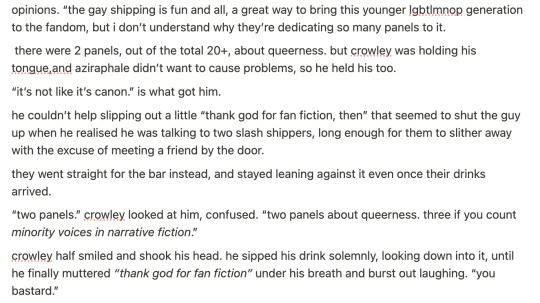
i haven't exactly decided what happens with the witchfinder, like if the story takes place over hundreds of years and he keeps reincarnating as the same lookin dude (like how jack whitehall plays both Thou Shall Not Commit Adultery and Newton Pulsifer) or if it's set over one lifetime and the witch just gets killed and regenerates a lot. i do like the idea of there being some "through the ages" shenanigans, and a canonical "modern day" setting like GO has.
but i gotta be careful bc i genuinely can't stop thinking about this fake story that's barely mentioned in my fan fic or i'll end up writing the damn thing myself
91 notes
·
View notes
Text
Who has a choice like Smarty does?

(tumblr sucks for restrictions with image sizings. the quality is fucked up)
July, 2024
Another addition to my portraits of Alfred.
Um... I don't really know. This time for real. Something hit me on the head, and I got the idea to create whatever this pink abomination is.
I have a habit of making things that make my eyes sore, though.
Confession: I love Alfred's Cold War era uniform (well, it's actually a variation of the WWII uniform). I depicted him wearing an Airborne one 'cause of the eagle patch on official artwork—the trademark of division. I've seen the other creators playing a guessing game with uniforms, so there really isn't a "canon" tradition to follow.

And also it's cunty-- I mean, the Ike jacket, the boots, the silly cap. Giving fierce.
I'm sorry... (• ▽ •;)
Personally, I always try to make clothing historically accurate. Then I should explain a few details. The long shoulder thingies—fourragères, left one—Belgian (it correlates with the red ropes that most artists drew on Alfred's uniform. It's the closest I could find that would be time-appropriate, and I saw that it could also have arm loops. More strings. So, a tricky fact: it should be worn on the left, but I read that it could be worn and was usually worn by soldiers on the right if there is a French Croix de Guerre 39/45 on the left, which is... the same-looking fourragère as Belgian. No braided strings staking!), the right one—Dutch lanyard (it's orange, close call to red! But, one big but, don't take my words seriously, 'cause I read too many different opinions on some 2007 forum discussion that I became confused with placement. I don't really know what is actually right, please don't come for me, I tried my best and it's only a drawing) and the French one, I've mentioned earlier.
Other accessories: on the left pocket—the presidential unit citation award; on the right, above the ribbon bar set (um, I won't specify what ribbons I could've depicted, as this post will become twice as long)—jump wings; and also the M1916 holster (colt is included!) on the leg. Did you know that little strap was used to secure the holster on the thigh? I didn't before diving into the hunt for references. The strap also could be tied in some peculiar knots, but Alfred is a messy bitch/j, and it means messy wrapping on the muzzle.
The autism in me powers the fuel of a research engine for a Hetalia fanart. Yikes.
One thing that I didn't want to change was the neck scarf. Sadly, there isn't one for real uniform, but I couldn't bring myself to get rid of it. It's just too iconic, even for my historical accuracy quirk. And the hat should be larger, however, I wasn't bothered about the right size. It's a mini-cap.
Okay, I need to address the elephant in the room. Yes, mouths. Different emotions (or I tried to make them different). Am I insane for this? Absolutely. They're reminding me of the first colour TV or ibm computers with Warhol's style.

The second ver is just text, which I thought suited him (tbh, Alfred would make great friends with Maxine, iykyk). I had great fun with distortion filters.
Last thing, the expression is supposed to be somewhat confused laughing like someone accused of something very controversial ("me kissing men??? oh nonono, haha... ',:D") and Alfred just laughs it off, like he usually does. At the same time, looking down on us, the viewer. Though you can freely interpret the expression however you want, it's up to you! (~ ̄▽ ̄)~
#hetalia#hws america#aph america#hws#aph#i didn't notice that adding a song automatically adds a spotify tag. what the actual fuck
27 notes
·
View notes
Text

March version drawn by @estellardreams
With my tumblrversary (and new sona design 👀) coming tomorrow, I thought it would be fun to look back at all the different versions of my sona throughout the years!
July 2023 version
December 2023 Version
March 2024 Version
Closeups and breakdown under the cut! :D

Version 1! This was the original drawing of my sona that I made for a story I was writing with my friends wherein we ourselves were the main characters. This drawing has the same straight cut bangs that I had back then. I designed the dress to be simple and not overly flashy. It's supposed to be white with gold borders. Then we have the wings, which have always been my favorite part of my sona, the gold feather necklace, and the gold band hidden under my bangs which was supposed to act as a crown. I also hid my hands behind my back because I didn't want to draw them. XD This design was supposed to mimic my irl appearance and it did fairly good job! The only thing missing is my glasses from back then.

Version 2! This one was an updated take on the first version. My art style had changed a bit, so I wanted to draw a better looking picture of my sona. Other than the art style, not much has changed here. The design is still essentially exactly the same. My hair got longer though.


Version [????] I didn't include these in the history pic because I forgot them, but these were two iterations that I did in between version 2 and 3 for thumbnails on my YT channel. They're both once again trying to be an accurate representation off my irl appearance (though once again my glasses weren't included. The first one was an attempt at a chibi art style which I never did again. The second one sat unfinished in my sketchbook for a while before my cousin visited one day and offered to help me color it. We took a picture of it on her ipad and then traced and colored it in whatever drawing program she was using. I played around a bit with the shirt, making it a white into black gradient and brought back in the feather motif because I've always liked feathers. This one stayed my profile pic on yt for a long time.


Version 3! Massive skip in time and drawing style here! This one was designed specifically so I could have an updated sona for when I joined tumblr. (I planned getting my account for months before I finally worked up enough courage to actually do it.) Once again, I wanted this sona to be an accurate representation of what I look like irl. Though THIS time I'd finally gotten contacts so the lack of glasses finally made sense! I'd also gotten a new style of bangs so I incorporated that into the design as well. I brought back the feather as a necklace because I've always liked it. Though for whatever reason I got rid of the wings???? Why. Why did I do that. I love them so much! I shortened the length of my hair back to something closer to version 1 as well. And fun fact about this one! By this point I'd gotten decently good at drawing Sonic characters, so I used my knowledge of how to draw them to draw this version of my sona. XD I wasn't concerned anymore about drawing in a realistic way and leaned into a more cartoony artystyle.

Version 4! honestly, this one was just me wanting to do a Christmas version of my sona. XD Gave myself a cozy Christmas sweater and a Santa hat! I also took my favorite golden feather and tucked it behind my ear. I honestly really like how it looks! (I also messed up the shade of brown for my hair, but oh well.)

Version 5!! Estelle drew this for me and I still love it so much!!!!! I didn't request this of her, she just drew it! I mentioned in a post that I needed a new icon since it was MARCH and I was still using my Christmas pic. XD Next thing I know Estelle is kicking down my door asking me if I wanted her to draw me a new icon. I made sure to specifically request that she include my wings since I'd finally realized how dumb it was that I'd taken them out. But other than that, I let Estelle do what she wanted and I'm SO happy with how it came out!! I really wish I'd used this one for longer, but then April Fools came along and I hopped on the pointing Sonic icon bandwagon. XD But anyway, I'm still very happy and thankful to Estelle for drawing this for me. :D
Annnnnd that catches us up to the present! What will the new version look like? You'll have to wait for tomorrow. :D
7 notes
·
View notes
Text
initial thoughts on DCAS episode 21
AKA, the finale :O this will be a doozy...

for Going Through It as frequently and as strongly as Jake does, i find it hilarious that all of his promotional material always looks like it was ripped straight from a dorky high school girl's instagram feed. also, go Ashley, roast that clown (/lh)

that's such a cute drawing omg!!! i always have fun thinking about how good the drawing is in the context of the universe it was drawn in. like, to us, his proportions look kinda off, but in their universe, the giant heads and tiny waists are actually really accurate. Hunter is going to be the next great artist fr.

... i thought that the point was supposed to be that Jake grew more than anyone here, which is why he was facing down Riya. i mean, i guess you could say that Ally had to grow a new personality for the beginning of the season, and then have that character develop. she is more changed from s2 Ally than Jake is from s1 Jake because Jake had more of a character in s1.

and boy, would it suck if that promise was left unfulfilled! (/s)

it is true that this (if she actually remained on Riya's team the whole time) is kind of a win-win for Ellie. either Riya loses, or she gets $100K. both are acceptable.

this was such a cute/fitting response for Jake to have. it's a really great button on their relationship.

i love how smug they look at no one wanting to help Riya.

WHEN THE FUCK WERE YOU WATERBOARDED???
actually, we know that Tom is a terrible liar, so maybe he got waterboarded by the mob boss after they figured out he was lying in the interrogation.

w... what...?

dare i say iconic

i know that they didn't really have time, but with Alec and Ellie working together (and Alec protecting Ellie, as he did here), i had kind of hoped that we'd get a bit more closure on their relationship. like, does Ellie still hate Alec for betraying her? or is the fact that they were going to be in the villains alliance together mean that they'd cross that bridge? maybe i'm just forgetting, but their relationship feels somewhat unresolved. (i mean relationship platonically btw; no hate to people who ship them but i don't need to know if they're a couple or not because the canon answer is obviously no)

i don't know if this was really necessarily but good for you girl

this is like the first time Fiore has cared about anyone ever :,D Fiore and Alec the duo ever!!!

A GENUINE SMILE????????

why are you preventing this from happening? you know Gabby, so you should know that this would absolutely work.

rewatching the beginning of the episode after knowing the end, i sorta wanted to question whether Ashley abstaining from helping could have accidentally lost Jake the win. however, Tom is just so doggedly determined to cover his man that i think he probably was the best guy for the job. like, would Ashley dive for him? idk.

okay, 1) WHAT THE FUCK DID YOU THINK THAT WAS GOING TO DO, RIYA?!?!, and 2) HOW THE FUCK DID GABBY NOT LOSE HER ARM FROM THIS. IMAGINE IF SHE DID. THIS WAS WILD.

... does Riya understand how pain works? or the American healthcare system? Ellie surely wanted to use that money for something else, dude.

so they are kinda sweeping Tom's wrongdoings under the rug, huh? sigh. hopefully it's just a "for now" thing to be further explored in the miniseries.

i love Trevor's little :3 face

and boy, would it suck if this favor was left unfulfilled! (/s)

i watched a compilation of each Disventure Camp character's first and last lines, and let me just say, it's really weird that "Go, Jake!" (said with Aiden) is James' last line ever.

GIVE UP ON HERRRRRRRRR
(also, glad his foot seems to be doing better)

i know i probably would have made fun of this scene for being super corny/moving too fast if Tom had said "i love you," but it's perhaps equally funny that he didn't. like, c'mon bro, you can't even muster the L word in this incredibly dramatic and heroic moment?

COPE

oh boy...
y'know, beyond just not having a good time slot in which to do so, i also kinda put off writing these initial thoughts because i just really didn't feel like having to write anything about ONC's choice regarding the winner of the season. everyone online seems to have these really radical opinions-- either saying that this was a brilliantly subversive and poetic choice, or that the entire season (and perhaps even s2 before it) are ruined by the choice to let Riya in. the truth is, i'm incredibly neutral.
on one hand, i'm incredibly disappointed. if you've been keeping up with these initial thoughts throughout the season, or especially my episode-by-episode power rankings, you'll know that i've very firmly believed that Jake was going to be the winner of this season since the beginning of the merge. and it's not because he's my favorite character and i really wanted him to win or anything-- i have a generally favorable opinion on Jake, but it was mostly because i thought that the arcs and messages of the season would be best capped off with a Jake win. therefore, it's saddening to believe that they didn't capitalize on all that potential just for the sake of shock value.
then again, i really appreciate what ONC was trying to do with Riya. i can tell that they must have felt like they had a lot to prove with Riya in DCAS given how mixed her reception was in s2. so, they put in a lot of work to "fix" her character in DCAS, and, on the whole, i think they got a lot better! as much as i was predicting the Jake win, i was also kind of dreading it, just because it was the sort of cheesy, fanservicey ending that could be predicted from a mile away. so i appreciate the boldness to go for an unexpected ending, and the refusal to stagnate in cookie cutter fan-pleasing storylines when your artistic heart is driving you in another direction.
which is why, in the end, i have no strong opinions. i think that the character writing absolutely could have been set up to establish viewer expectations better, but i also don't think that the entire season is unwatchable because Riya wins. the truth of the matter is still that all of the other contestants besides Yul are the real winners of the season, because they made friends and grew as people. if you rewatch the season, you can still see the gang do just that. but the equal truth is that all of the promises those friends made and the goal that drove them to improve might all feel a bit more hopeless with the knowledge that Connor never did get to one-up Riya. People who needed the money more, like Ashley, Alec, or Ellie didn't get a cent of it. and unlike it would be for Jake, who had a lot of connections with a lot of people, many contestants had pretty much no bearing on the winner of the season at all.
i want to believe that the Disventure Camp writing can and will continue to overall get better, but i also can't ignore the obvious signs of growing pains. can't bring myself to get all too mad at them either, though. mostly, i just want to stay out of any drama.

it really shows that Jake hasn't been able to look at social media since the beginning of the show. trust me, buddy, not everyone was rooting for you.

unsurprising that tomjake gets the last kiss of the season/era.

cite your sources, please (/j)

i guess the real person Riya was lying to all along... was herself. *vine boom* because, seriously, how the fuck did she not realize that it wasn't just acting anymore? when she double-broke Connor's foot and tried to make Ally think that Jake lied about being suicidal???
#disventure camp#dcas#dcas initial thoughts#disventure camp spoilers#dcas spoilers#i need more images again hang on
6 notes
·
View notes
Text
AI Bots - Are They Problematic and Should I Use Them?
With all of the uproar going on with Artificial Intelligence having the capabilities of scraping various fanfiction sites (AO3) as well as artwork sites (DeviantArt) and plagiarizing them, I wanted to give my two cents on whether or not it's okay to even use AI sites or AI programs or AI chatbots.
Some of the most iconic programs, sites, and chatbots include Cleverbot, Grammarly, Notion, and ChatGPT. Everyone has used Cleverbot at one point or another for laughs and seeing what nonsense it'll come up with. Grammarly is great when it comes to ... well ... grammar. Notion is unique in the sense that it's a writing document app with an AI built into it (and you can actually use Grammarly along with it). Which leaves us with none other than ... ... ... ... ... ChatGPT.
AIs like ChatGPT (and Dall-E) are nothing short of problematic because there are ways for people to scrape various websites. This is problematic because not only do they invade privacy but also tends to more or less take bits and pieces, if not all, of people's works (be it written, drawn, both, neither, etc.). Another problem with using AI bots is that there are a lot of people who use them to write their essays and creative assignments for school (especially college). This is incredibly problematic for a couple of reasons.
It can be taken as (and assumed that) the students were being lazy and aren't learning anything. It's like what this article on Scribber says, "Not doing the work yourself is academically dishonest, undermines your learning, and is unfair to other students."
It can, and perhaps will, cause problems later on down the road. The reason for this is because we all have a distinct voice and way we phrase things. And this is true when it comes to not only writing stories and drawing art but doing essays, art projects, and what have you.
AIs are slowly, but surely, making people lose their jobs. There are fast food restaurants and movie theaters that are already using AI machines and are somewhat in the process of hiring fewer people than before. We also have those who are in the art industry (mainly writers and drawers) who are in constant fear of losing their jobs because of AI. Doesn't help that we, the artists, aren't taken seriously as it is hence there being a Writers Strike.
Now me bringing up these three major points doesn't necessarily mean that I'm anti-AI. I'm anti-plagiarism and anti-scraping. I'm also perfectly fine with people who are disabled and are in need of using AI bots (or a program) to assist them. That's why we have programs such as Grammarly, Hemmingway App, Notion, Google Translate, and DeepL. They help us get a general idea of how to phrase, word, punctuate, and even translate things. They might not always be 100% accurate or reliable but they are there.
So, at the end of the day, it all really boils down to what you're using AI bots for. Using it because you want to improve on your grammar, spelling, and punctuation? That's okay. Using it to write your whole entire five page essay? That's not okay. Using it for research purposes like briefly explaining the similarities and differences between Thor and Raijin? That's okay. Using it to write a whole ass fanfic for you? That's not okay. Using it because you have a disability and need a voice (or whatever the case may be)? That's okay. Using it as your sole resource for research, translation, and whatnot followed by saying "AI bots are flawless, you're just jealous."? That's not okay.
So with all of that being said, AI works aren't exactly transformative, original, or creative. It's amusing as hell to see kind of shenaningans and malarkey will pop out when asking for a fanfic of a specific pairing, sure, but I wouldn't post any of it online because it's not my cup of tea. Something else to keep in mind is that, like us humans, AIs tend to make mistakes. And last, but not least, keep in mind that many of them genuinely don't care about our privacy. You can use the argument that most websites don't, and I wholeheartedly agree with you, but the point still stands.
Either way, I think it all ultimately depends on the situation for what is and isn't okay in terms of AI usage. The same is equally true on personal preferences and opinions.
7 notes
·
View notes
Text
I do in fact know about angst content, because I have basic knowledge of the platform I'm on, believe it or not.
"Abuser" was a harsh term, I know that and I knew that. A more accurate term would've been "someone who hurt the deceased in their past and shouldn't have been invited." I used a severe and callous analogy, but I don't know how comparison is equally bad as actually committing a crime.
The MLP gore that I witnessed is and has always been "untagged". How am I supposed to avoid seeing YouTube thumbnails? Because that, and mistakenly clicking on the more innocent-appearing ones when I was younger, were the only ways that I was exposed.
Im sorry but if the majority of Infection AU fans are my age and enjoyed gore growing up... I genuinely think something is wrong with them and they should talk about that with a mental health professional. I've never understood what draws kids to horror movies, so I have no idea what's going on here.
Of course I'm not comparing people who grew up on MLP gore to abusers... I'm comparing people who were adults at the time and created half of the most iconic animations in the fandom to people who don't belong at a funeral for the show.
I have a really hard time judging bad character in people, so I genuinely can't tell when someone is being entitled like you can. If it's because I demanded people stop making art, I have friends who explained to me how wrong I was and are teaching me to learn not to expect people to cater to my whims when it comes to self-expression, even when it reminds me of my trauma. Whether I like it or not, people are going to trigger me, and I can't get mad at them because that makes me a control freak. And I get it! My mom likes my hair a certain way and I refuse to adhere to her preferences.
On a side note, I removed the post from the main tag. Why did you go search for it?
I was already upset that day and seeing that content for the first time spurred me into a rage, and I posted it because I thought someone might agree with me. Obviously all I've done is hurt people, so if enough people tell me that this entire post reeks of entitlement I will delete it completely. Keep in mind though that everytime someone infantilizes me I have more incentive to keep it up out of spite. You can tell me I'm being disgusting and entitled without calling me a brat or saying I need a bedtime.
to all the people making fanart about My Little Pony infection AUs:
That was my childhood! MY. CHILDHOOD! My largest source of happiness because I sure as hell wasn't getting that from my family or anybody I interacted with after leaving the house. I lived vicariously through the Main Six because I apparently didn't understand how friendship worked since people either avoided me and gave me looks or pretended to be my friend just to gaslight me afterward (like i wasnt getting enough of that at home). The few friends I did manage to get never lasted long, and I'd spend hours wallowing in jealousy because my siblings managed to manifest massive friend groups despite being absolutely awful.
I happened upon Cupcakes by accident like so many other children and I could never look at my favourite show the same way again. Even when I was enjoying it there would always be those terrifying images at the back of my mind. Not even the most innocent media in my childhood were safe from adults who "liked" children.
You ruined it! You ruined the one good thing I had! And now you have the gall to be like
"Hey, remember when we destroyed the innocence of thousands of children and drew and wrote so much heinous art that we became an entire subset of the fandom? That was fun! Lets do that again, for old time's sake."
FUCK YOU. How come you get to enjoy your nostalgia at the expense of the people you already actively prevented from experiencing? How come you get to ruin the corpse of the characters you ruined during their life?
I don't fucking care if you're neurodivergent! I am too and you actively took away the only source of joy I had when I was surrounded by ableism on all sides. If you can't tell, this is an extremely personal subject to me!
The MLP revival shouldn't be more creepypasta shit. And don't you DARE call me a white Karen mom about this. Because of you, MLP is known for horror and characters brutally murdering each other, and don't get me wrong! I love that shit! I'm in the life series fandom for God's sake! I was a Magnus Archives fan! But this is different! This is an innocent piece of media I was LIVING on.
Can you all just fucking stay out of it? I would rather a timeline where only a few people made MLP fanworks in 2024 and were made fun of than you all doing this with its legacy. Abusers shouldn't be able to kick the actual mourners out of a funeral and assault whoever, dead or alive, is left.
Ive never understood the reason why people make DNI lists but I think I'm getting it now! Istg, if you come at me with more MLP horror, I am blocking you, and if you make fun of that statement I'm sorry but I would deck you in the face if you did that IRL because how dare you laugh at a person this angry? I get enough of that on the regular already and I don't need people I could've been friends with online adding themselves to the list.
Now how about you all squash your indeserved and harmful nostalgia and LEAVE so that us traumatized kids can enjoy what little content we still make?
9 notes
·
View notes
Text
Actually, piggybacking off of that ask to go a bit more in depth as to what Morstikan people look like (because I think about fictional biology way too much and I’ve already gone a little in depth about their hair texture so!!) and how the Castelleves differ due to their own heritage (demigods + being mixed race) aside from the ‘otherworldy’ traits like scales and super sharp teeth that I’ve already talked about before.
A lot of Morstikan people, around 70%-75%, had epicanthal folds - Henri, for example, actually has very pronounced ones (as does Beau and Pavati), whereas Krisha and Damian don’t have them at all (a trait they get from their biological grandfather on Henri’s side, Edward, who was Feueran. For a real-world equivalent, think Austria, Hungary, Germany, etc.) and the rest of the Castelleves and most Morstikans have only somewhat pronounced epicanthal folds.
Morstikans typically have green or brown eyes (Krisha has green eyes), however demigods tend to have an unnaturally light blue or yellow eye color. This is where the Castelleves get their ice-like blue eyes, with the exception of Irina who has a deeper, more ocean blue color and passed that on to Damian and Beau. It should be noted, though, that Noemie had yellow eyes when she was alive, as did Pavati’s father/Henri’s grandfather.
#this is basically as far as I've gotten as far as racial characteristics go for Morstikans and the Castelleves in specific#the manga FCs I have dont really do that great of a job portraying their actual features they just tend to hit the right vibe#or get things /mostly/ right but not 100%#i really need to actually DRAW them more so I have more accurate icons#fghdsfd but yeah anyway critique wanted and appreciated#if you see anything flawed and/or disrespectful plz let me know cause i dont want to perpetuate stereotypes or anything harmful like that!!#i dont think theres anything like that here but you never knw#know*#Lore Database#I'm The Definition Of The Worst Kind Of Mean // Henri Headcanons#I Drag You Down; I Use You Up - Mr Self Destruct // Damian Headcanons#Another Day; Another Week; Another Month; Another Year // Mortau Headcanons#Wearing a Warning Sign; Wait Till The World Is Mine // Sylvester Headcanons#Winding all the Dials and the Wires and the Spires // Krisha Headcanons#Patrons of the Moon // Serena Headcanons
2 notes
·
View notes
Text
The Green Knight and Medieval Metatextuality: An Essay
Right, so. Finally watched it last night, and I’ve been thinking about it literally ever since, except for the part where I was asleep. As I said to fellow medievalist and admirer of Dev Patel @oldshrewsburyian, it’s possibly the most fascinating piece of medieval-inspired media that I’ve seen in ages, and how refreshing to have something in this genre that actually rewards critical thought and deep analysis, rather than me just fulminating fruitlessly about how popular media thinks that slapping blood, filth, and misogyny onto some swords and castles is “historically accurate.” I read a review of TGK somewhere that described it as the anti-Game of Thrones, and I’m inclined to think that’s accurate. I didn’t agree with all of the film’s tonal, thematic, or interpretative choices, but I found them consistently stylish, compelling, and subversive in ways both small and large, and I’m gonna have to write about it or I’ll go crazy. So. Brace yourselves.
(Note: My PhD is in medieval history, not medieval literature, and I haven’t worked on SGGK specifically, but I am familiar with it, its general cultural context, and the historical influences, images, and debates that both the poem and the film referenced and drew upon, so that’s where this meta is coming from.)
First, obviously, while the film is not a straight-up text-to-screen version of the poem (though it is by and large relatively faithful), it is a multi-layered meta-text that comments on the original Sir Gawain and the Green Knight, the archetypes of chivalric literature as a whole, modern expectations for medieval films, the hero’s journey, the requirements of being an “honorable knight,” and the nature of death, fate, magic, and religion, just to name a few. Given that the Arthurian legendarium, otherwise known as the Matter of Britain, was written and rewritten over several centuries by countless authors, drawing on and changing and hybridizing interpretations that sometimes challenged or outright contradicted earlier versions, it makes sense for the film to chart its own path and make its own adaptational decisions as part of this multivalent, multivocal literary canon. Sir Gawain himself is a canonically and textually inconsistent figure; in the movie, the characters merrily pronounce his name in several different ways, most notably as Sean Harris/King Arthur’s somewhat inexplicable “Garr-win.” He might be a man without a consistent identity, but that’s pointed out within the film itself. What has he done to define himself, aside from being the king’s nephew? Is his quixotic quest for the Green Knight actually going to resolve the question of his identity and his honor – and if so, is it even going to matter, given that successful completion of the “game” seemingly equates with death?
Likewise, as the anti-Game of Thrones, the film is deliberately and sometimes maddeningly non-commercial. For an adaptation coming from a studio known primarily for horror, it almost completely eschews the cliché that gory bloodshed equals authentic medievalism; the only graphic scene is the Green Knight’s original beheading. The violence is only hinted at, subtextual, suspenseful; it is kept out of sight, around the corner, never entirely played out or resolved. In other words, if anyone came in thinking that they were going to watch Dev Patel luridly swashbuckle his way through some CGI monsters like bad Beowulf adaptations of yore, they were swiftly disappointed. In fact, he seems to spend most of his time being wet, sad, and failing to meet the moment at hand (with a few important exceptions).
The film unhurriedly evokes a medieval setting that is both surreal and defiantly non-historical. We travel (in roughly chronological order) from Anglo-Saxon huts to Romanesque halls to high-Gothic cathedrals to Tudor villages and half-timbered houses, culminating in the eerie neo-Renaissance splendor of the Lord and Lady’s hall, before returning to the ancient trees of the Green Chapel and its immortal occupant: everything that has come before has now returned to dust. We have been removed even from imagined time and place and into a moment where it ceases to function altogether. We move forward, backward, and sideways, as Gawain experiences past, present, and future in unison. He is dislocated from his own sense of himself, just as we, the viewers, are dislocated from our sense of what is the “true” reality or filmic narrative; what we think is real turns out not to be the case at all. If, of course, such a thing even exists at all.
This visual evocation of the entire medieval era also creates a setting that, unlike GOT, takes pride in rejecting absolutely all political context or Machiavellian maneuvering. The film acknowledges its own cultural ubiquity and the question of whether we really need yet another King Arthur adaptation: none of the characters aside from Gawain himself are credited by name. We all know it’s Arthur, but he’s listed only as “king.” We know the spooky druid-like old man with the white beard is Merlin, but it’s never required to spell it out. The film gestures at our pre-existing understanding; it relies on us to fill in the gaps, cuing us to collaboratively produce the story with it, positioning us as listeners as if we were gathered to hear the original poem. Just like fanfiction, it knows that it doesn’t need to waste time introducing every single character or filling in ultimately unnecessary background knowledge, when the audience can be relied upon to bring their own.
As for that, the film explicitly frames itself as a “filmed adaptation of the chivalric romance” in its opening credits, and continues to play with textual referents and cues throughout: telling us where we are, what’s happening, or what’s coming next, rather like the rubrics or headings within a medieval manuscript. As noted, its historical/architectural references span the entire medieval European world, as does its costume design. I was particularly struck by the fact that Arthur and Guinevere’s crowns resemble those from illuminated monastic manuscripts or Eastern Orthodox iconography: they are both crown and halo, they confer an air of both secular kingship and religious sanctity. The question in the film’s imagined epilogue thus becomes one familiar to Shakespeare’s Henry V: heavy is the head that wears the crown. Does Gawain want to earn his uncle’s crown, take over his place as king, bear the fate of Camelot, become a great ruler, a husband and father in ways that even Arthur never did, only to see it all brought to dust by his cowardice, his reliance on unscrupulous sorcery, and his unfulfilled promise to the Green Knight? Is it better to have that entire life and then lose it, or to make the right choice now, even if it means death?
Likewise, Arthur’s kingly mantle is Byzantine in inspiration, as is the icon of the Virgin Mary-as-Theotokos painted on Gawain’s shield (which we see broken apart during the attack by the scavengers). The film only glances at its religious themes rather than harping on them explicitly; we do have the cliché scene of the male churchmen praying for Gawain’s safety, opposite Gawain’s mother and her female attendants working witchcraft to protect him. (When oh when will I get my film that treats medieval magic and medieval religion as the complementary and co-existing epistemological systems that they were, rather than portraying them as diametrically binary and disparagingly gendered opposites?) But despite the interim setbacks borne from the failure of Christian icons, the overall resolution of the film could serve as the culmination of a medieval Christian morality tale: Gawain can buy himself a great future in the short term if he relies on the protection of the enchanted green belt to avoid the Green Knight’s killing stroke, but then he will have to watch it all crumble until he is sitting alone in his own hall, his children dead and his kingdom destroyed, as a headless corpse who only now has been brave enough to accept his proper fate. By removing the belt from his person in the film’s Inception-like final scene, he relinquishes the taint of black magic and regains his religious honor, even at the likely cost of death. That, the medieval Christian morality tale would agree, is the correct course of action.
Gawain’s encounter with St. Winifred likewise presents a more subtle vision of medieval Christianity. Winifred was an eighth-century Welsh saint known for being beheaded, after which (by the power of another saint) her head was miraculously restored to her body and she went on to live a long and holy life. It doesn’t quite work that way in TGK. (St Winifred’s Well is mentioned in the original SGGK, but as far as I recall, Gawain doesn’t meet the saint in person.) In the film, Gawain encounters Winifred’s lifelike apparition, who begs him to dive into the mere and retrieve her head (despite appearances, she warns him, it is not attached to her body). This fits into the pattern of medieval ghost stories, where the dead often return to entreat the living to help them finish their business; they must be heeded, but when they are encountered in places they shouldn’t be, they must be put back into their proper physical space and reminded of their real fate. Gawain doesn’t follow William of Newburgh’s practical recommendation to just fetch some brawny young men with shovels to beat the wandering corpse back into its grave. Instead, in one of his few moments of unqualified heroism, he dives into the dark water and retrieves Winifred’s skull from the bottom of the lake. Then when he returns to the house, he finds the rest of her skeleton lying in the bed where he was earlier sleeping, and carefully reunites the skull with its body, finally allowing it to rest in peace.
However, Gawain’s involvement with Winifred doesn’t end there. The fox that he sees on the bank after emerging with her skull, who then accompanies him for the rest of the film, is strongly implied to be her spirit, or at least a companion that she has sent for him. Gawain has handled a saint’s holy bones; her relics, which were well known to grant protection in the medieval world. He has done the saint a service, and in return, she extends her favor to him. At the end of the film, the fox finally speaks in a human voice, warning him not to proceed to the fateful final encounter with the Green Knight; it will mean his death. The symbolism of having a beheaded saint serve as Gawain’s guide and protector is obvious, since it is the fate that may or may not lie in store for him. As I said, the ending is Inception-like in that it steadfastly refuses to tell you if the hero is alive (or will live) or dead (or will die). In the original SGGK, of course, the Green Knight and the Lord turn out to be the same person, Gawain survives, it was all just a test of chivalric will and honor, and a trap put together by Morgan Le Fay in an attempt to frighten Guinevere. It’s essentially able to be laughed off: a game, an adventure, not real. TGK takes this paradigm and flips it (to speak…) on its head.
Gawain’s rescue of Winifred’s head also rewards him in more immediate terms: his/the Green Knight’s axe, stolen by the scavengers, is miraculously restored to him in her cottage, immediately and concretely demonstrating the virtue of his actions. This is one of the points where the film most stubbornly resists modern storytelling conventions: it simply refuses to add in any kind of “rational” or “empirical” explanation of how else it got there, aside from the grace and intercession of the saint. This is indeed how it works in medieval hagiography: things simply reappear, are returned, reattached, repaired, made whole again, and Gawain’s lost weapon is thus restored, symbolizing that he has passed the test and is worthy to continue with the quest. The film’s narrative is not modernizing its underlying medieval logic here, and it doesn’t particularly care if a modern audience finds it “convincing” or not. As noted, the film never makes any attempt to temporalize or localize itself; it exists in a determinedly surrealist and ahistorical landscape, where naked female giants who look suspiciously like Tilda Swinton roam across the wild with no necessary explanation. While this might be frustrating for some people, I actually found it a huge relief that a clearly fantastic and fictional literary adaptation was not acting like it was qualified to teach “real history” to its audience. Nobody would come out of TGK thinking that they had seen the “actual” medieval world, and since we have enough of a problem with that sort of thing thanks to GOT, I for one welcome the creation of a medieval imaginative space that embraces its eccentric and unrealistic elements, rather than trying to fit them into the Real Life box.
This plays into the fact that the film, like a reused medieval manuscript containing more than one text, is a palimpsest: for one, it audaciously rewrites the entire Arthurian canon in the wordless vision of Gawain’s life after escaping the Green Knight (I could write another meta on that dream-epilogue alone). It moves fluidly through time and creates alternate universes in at least two major points: one, the scene where Gawain is tied up and abandoned by the scavengers and that long circling shot reveals his skeletal corpse rotting on the sward, only to return to our original universe as Gawain decides that he doesn’t want that fate, and two, Gawain as King. In this alternate ending, Arthur doesn’t die in battle with Mordred, but peaceably in bed, having anointed his worthy nephew as his heir. Gawain becomes king, has children, gets married, governs Camelot, becomes a ruler surpassing even Arthur, but then watches his son get killed in battle, his subjects turn on him, and his family vanish into the dust of his broken hall before he himself, in despair, pulls the enchanted scarf out of his clothing and succumbs to his fate.
In this version, Gawain takes on the responsibility for the fall of Camelot, not Arthur. This is the hero’s burden, but he’s obtained it dishonorably, by cheating. It is a vivid but mimetic future which Gawain (to all appearances) ultimately rejects, returning the film to the realm of traditional Arthurian canon – but not quite. After all, if Gawain does get beheaded after that final fade to black, it would represent a significant alteration from the poem and the character’s usual arc. Are we back in traditional canon or aren’t we? Did Gawain reject that future or didn’t he? Do all these alterities still exist within the visual medium of the meta-text, and have any of them been definitely foreclosed?
Furthermore, the film interrogates itself and its own tropes in explicit and overt ways. In Gawain’s conversation with the Lord, the Lord poses the question that many members of the audience might have: is Gawain going to carry out this potentially pointless and suicidal quest and then be an honorable hero, just like that? What is he actually getting by staggering through assorted Irish bogs and seeming to reject, rather than embrace, the paradigms of a proper quest and that of an honorable knight? He lies about being a knight to the scavengers, clearly out of fear, and ends up cravenly bound and robbed rather than fighting back. He denies knowing anything about love to the Lady (played by Alicia Vikander, who also plays his lover at the start of the film with a decidedly ropey Yorkshire accent, sorry to say). He seems to shrink from the responsibility thrust on him, rather than rise to meet it (his only honorable act, retrieving Winifred’s head, is discussed above) and yet here he still is, plugging away. Why is he doing this? What does he really stand to gain, other than accepting a choice and its consequences (somewhat?) The film raises these questions, but it has no plans to answer them. It’s going to leave you to think about them for yourself, and it isn’t going to spoon-feed you any ultimate moral or neat resolution. In this interchange, it’s easy to see both the echoes of a formal dialogue between two speakers (a favored medieval didactic tactic) and the broader purpose of chivalric literature: to interrogate what it actually means to be a knight, how personal honor is generated, acquired, and increased, and whether engaging in these pointless and bloody “war games” is actually any kind of real path to lasting glory.
The film’s treatment of race, gender, and queerness obviously also merits comment. By casting Dev Patel, an Indian-born actor, as an Arthurian hero, the film is… actually being quite accurate to the original legends, doubtless much to the disappointment of assorted internet racists. The thirteenth-century Arthurian romance Parzival (Percival) by the German poet Wolfram von Eschenbach notably features the character of Percival’s mixed-race half-brother, Feirefiz, son of their father by his first marriage to a Muslim princess. Feirefiz is just as heroic as Percival (Gawaine, for the record, also plays a major role in the story) and assists in the quest for the Holy Grail, though it takes his conversion to Christianity for him to properly behold it.
By introducing Patel (and Sarita Chowdhury as Morgause) to the visual representation of Arthuriana, the film quietly does away with the “white Middle Ages” cliché that I have complained about ad nauseam; we see background Asian and black members of Camelot, who just exist there without having to conjure up some complicated rationale to explain their presence. The Lady also uses a camera obscura to make Gawain’s portrait. Contrary to those who might howl about anachronism, this technique was known in China as early as the fourth century BCE and the tenth/eleventh century Islamic scholar Ibn al-Haytham was probably the best-known medieval authority to write on it extensively; Latin translations of his work inspired European scientists from Roger Bacon to Leonardo da Vinci. Aside from the symbolism of an upside-down Gawain (and when he sees the portrait again during the ‘fall of Camelot’, it is right-side-up, representing that Gawain himself is in an upside-down world), this presents a subtle challenge to the prevailing Eurocentric imagination of the medieval world, and draws on other global influences.
As for gender, we have briefly touched on it above; in the original SGGK, Gawain’s entire journey is revealed to be just a cruel trick of Morgan Le Fay, simply trying to destabilize Arthur’s court and upset his queen. (Morgan is the old blindfolded woman who appears in the Lord and Lady’s castle and briefly approaches Gawain, but her identity is never explicitly spelled out.) This is, obviously, an implicitly misogynistic setup: an evil woman plays a trick on honorable men for the purpose of upsetting another woman, the honorable men overcome it, the hero survives, and everyone presumably lives happily ever after (at least until Mordred arrives).
Instead, by plunging the outcome into doubt and the hero into a much darker and more fallible moral universe, TGK shifts the blame for Gawain’s adventure and ultimate fate from Morgan to Gawain himself. Likewise, Guinevere is not the passive recipient of an evil deception but in a way, the catalyst for the whole thing. She breaks the seal on the Green Knight’s message with a weighty snap; she becomes the oracle who reads it out, she is alarming rather than alarmed, she disrupts the complacency of the court and silently shows up all the other knights who refuse to step forward and answer the Green Knight’s challenge. Gawain is not given the ontological reassurance that it’s just a practical joke and he’s going to be fine (and thanks to the unresolved ending, neither are we). The film instead takes the concept at face value in order to push the envelope and ask the simple question: if a man was going to be actually-for-real beheaded in a year, why would he set out on a suicidal quest? Would you, in Gawain’s place, make the same decision to cast aside the enchanted belt and accept your fate? Has he made his name, will he be remembered well? What is his legacy?
Indeed, if there is any hint of feminine connivance and manipulation, it arrives in the form of the implication that Gawain’s mother has deliberately summoned the Green Knight to test her son, prove his worth, and position him as his childless uncle’s heir; she gives him the protective belt to make sure he won’t actually die, and her intention all along was for the future shown in the epilogue to truly play out (minus the collapse of Camelot). Only Gawain loses the belt thanks to his cowardice in the encounter with the scavengers, regains it in a somewhat underhanded and morally questionable way when the Lady is attempting to seduce him, and by ultimately rejecting it altogether and submitting to his uncertain fate, totally mucks up his mother’s painstaking dynastic plans for his future. In this reading, Gawain could be king, and his mother’s efforts are meant to achieve that goal, rather than thwart it. He is thus required to shoulder his own responsibility for this outcome, rather than conveniently pawning it off on an “evil woman,” and by extension, the film asks the question: What would the world be like if men, especially those who make war on others as a way of life, were actually forced to face the consequences of their reckless and violent actions? Is it actually a “game” in any sense of the word, especially when chivalric literature is constantly preoccupied with the question of how much glorious violence is too much glorious violence? If you structure social prestige for the king and the noble male elite entirely around winning battles and existing in a state of perpetual war, when does that begin to backfire and devour the knightly class – and the rest of society – instead?
This leads into the central theme of Gawain’s relationships with the Lord and Lady, and how they’re treated in the film. The poem has been repeatedly studied in terms of its latent (and sometimes… less than latent) queer subtext: when the Lord asks Gawain to pay back to him whatever he should receive from his wife, does he already know what this involves; i.e. a physical and romantic encounter? When the Lady gives kisses to Gawain, which he is then obliged to return to the Lord as a condition of the agreement, is this all part of a dastardly plot to seduce him into a kinky green-themed threesome with a probably-not-human married couple looking to spice up their sex life? Why do we read the Lady’s kisses to Gawain as romantic but Gawain’s kisses to the Lord as filial, fraternal, or the standard “kiss of peace” exchanged between a liege lord and his vassal? Is Gawain simply being a dutiful guest by honoring the bargain with his host, actually just kissing the Lady again via the proxy of her husband, or somewhat more into this whole thing with the Lord than he (or the poet) would like to admit? Is the homosocial turning homoerotic, and how is Gawain going to navigate this tension and temptation?
If the question is never resolved: well, welcome to one of the central medieval anxieties about chivalry, knighthood, and male bonds! As I have written about before, medieval society needed to simultaneously exalt this as the most honored and noble form of love, and make sure it didn’t accidentally turn sexual (once again: how much male love is too much male love?). Does the poem raise the possibility of serious disruption to the dominant heteronormative paradigm, only to solve the problem by interpreting the Gawain/Lady male/female kisses as romantic and sexual and the Gawain/Lord male/male kisses as chaste and formal? In other words, acknowledging the underlying anxiety of possible homoeroticism but ultimately reasserting the heterosexual norm? The answer: Probably?!?! Maybe?!?! Hell if we know??! To say the least, this has been argued over to no end, and if you locked a lot of medieval history/literature scholars into a room and told them that they couldn’t come out until they decided on one clear answer, they would be in there for a very long time. The poem seemingly invokes the possibility of a queer reading only to reject it – but once again, as in the question of which canon we end up in at the film’s end, does it?
In some lights, the film’s treatment of this potential queer reading comes off like a cop-out: there is only one kiss between Gawain and the Lord, and it is something that the Lord has to initiate after Gawain has already fled the hall. Gawain himself appears to reject it; he tells the Lord to let go of him and runs off into the wilderness, rather than deal with or accept whatever has been suggested to him. However, this fits with film!Gawain’s pattern of rejecting that which fundamentally makes him who he is; like Peter in the Bible, he has now denied the truth three times. With the scavengers he denies being a knight; with the Lady he denies knowing about courtly love; with the Lord he denies the central bond of brotherhood with his fellows, whether homosocial or homoerotic in nature. I would go so far as to argue that if Gawain does die at the end of the film, it is this rejected kiss which truly seals his fate. In the poem, the Lord and the Green Knight are revealed to be the same person; in the film, it’s not clear if that’s the case, or they are separate characters, even if thematically interrelated. If we assume, however, that the Lord is in fact still the human form of the Green Knight, then Gawain has rejected both his kiss of peace (the standard gesture of protection offered from lord to vassal) and any deeper emotional bond that it can be read to signify. The Green Knight could decide to spare Gawain in recognition of the courage he has shown in relinquishing the enchanted belt – or he could just as easily decide to kill him, which he is legally free to do since Gawain has symbolically rejected the offer of brotherhood, vassalage, or knight-bonding by his unwise denial of the Lord’s freely given kiss. Once again, the film raises the overall thematic and moral question and then doesn’t give one straight (ahem) answer. As with the medieval anxieties and chivalric texts that it is based on, it invokes the specter of queerness and then doesn’t neatly resolve it. As a modern audience, we find this unsatisfying, but once again, the film is refusing to conform to our expectations.
As has been said before, there is so much kissing between men in medieval contexts, both ceremonial and otherwise, that we’re left to wonder: “is it gay or is it feudalism?” Is there an overtly erotic element in Gawain and the Green Knight’s mutual “beheading” of each other (especially since in the original version, this frees the Lord from his curse, functioning like a true love’s kiss in a fairytale). While it is certainly possible to argue that the film has “straightwashed” its subject material by removing the entire sequence of kisses between Gawain and the Lord and the unresolved motives for their existence, it is a fairly accurate, if condensed, representation of the anxieties around medieval knightly bonds and whether, as Carolyn Dinshaw put it, a (male/male) “kiss is just a kiss.” After all, the kiss between Gawain and the Lady is uncomplicatedly read as sexual/romantic, and that context doesn’t go away when Gawain is kissing the Lord instead. Just as with its multiple futurities, the film leaves the question open-ended. Is it that third and final denial that seals Gawain’s fate, and if so, is it asking us to reflect on why, specifically, he does so?
The film could play with both this question and its overall tone quite a bit more: it sometimes comes off as a grim, wooden, over-directed Shakespearean tragedy, rather than incorporating the lively and irreverent tone that the poem often takes. It’s almost totally devoid of humor, which is unfortunate, and the Grim Middle Ages aesthetic is in definite evidence. Nonetheless, because of the comprehensive de-historicizing and the obvious lack of effort to claim the film as any sort of authentic representation of the medieval past, it works. We are not meant to understand this as a historical document, and so we have to treat it on its terms, by its own logic, and by its own frames of reference. In some ways, its consistent opacity and its refusal to abide by modern rules and common narrative conventions is deliberately meant to challenge us: as before, when we recognize Arthur, Merlin, the Round Table, and the other stock characters because we know them already and not because the film tells us so, we have to fill in the gaps ourselves. We are watching the film not because it tells us a simple adventure story – there is, as noted, shockingly little action overall – but because we have to piece together the metatext independently and ponder the philosophical questions that it leaves us with. What conclusion do we reach? What canon do we settle in? What future or resolution is ultimately made real? That, the film says, it can’t decide for us. As ever, it is up to future generations to carry on the story, and decide how, if at all, it is going to survive.
(And to close, I desperately want them to make my much-coveted Bisclavret adaptation now in more or less the same style, albeit with some tweaks. Please.)
Further Reading
Ailes, Marianne J. ‘The Medieval Male Couple and the Language of Homosociality’, in Masculinity in Medieval Europe, ed. by Dawn M. Hadley (Harlow: Longman, 1999), pp. 214–37.
Ashton, Gail. ‘The Perverse Dynamics of Sir Gawain and the Green Knight’, Arthuriana 15 (2005), 51–74.
Boyd, David L. ‘Sodomy, Misogyny, and Displacement: Occluding Queer Desire in Sir Gawain and the Green Knight’, Arthuriana 8 (1998), 77–113.
Busse, Peter. ‘The Poet as Spouse of his Patron: Homoerotic Love in Medieval Welsh and Irish Poetry?’, Studi Celtici 2 (2003), 175–92.
Dinshaw, Carolyn. ‘A Kiss Is Just a Kiss: Heterosexuality and Its Consolations in Sir Gawain and the Green Knight’, Diacritics 24 (1994), 205–226.
Kocher, Suzanne. ‘Gay Knights in Medieval French Fiction: Constructs of Queerness and Non-Transgression’, Mediaevalia 29 (2008), 51–66.
Karras, Ruth Mazo. ‘Knighthood, Compulsory Heterosexuality, and Sodomy’ in The Boswell Thesis: Essays on Christianity, Social Tolerance, and Homosexuality, ed. Matthew Kuefler (Chicago: University of Chicago Press, 2006), pp. 273–86.
Kuefler, Matthew. ‘Male Friendship and the Suspicion of Sodomy in Twelfth-Century France’, in The Boswell Thesis: Essays on Christianity, Social Tolerance, and Homosexuality, ed. Matthew Kuefler (Chicago: University of Chicago Press, 2006), pp. 179–214.
McVitty, E. Amanda, ‘False Knights and True Men: Contesting Chivalric Masculinity in English Treason Trials, 1388–1415,’ Journal of Medieval History 40 (2014), 458–77.
Mieszkowski, Gretchen. ‘The Prose Lancelot's Galehot, Malory's Lavain, and the Queering of Late Medieval Literature’, Arthuriana 5 (1995), 21–51.
Moss, Rachel E. ‘ “And much more I am soryat for my good knyghts’ ”: Fainting, Homosociality, and Elite Male Culture in Middle English Romance’, Historical Reflections / Réflexions historiques 42 (2016), 101–13.
Zeikowitz, Richard E. ‘Befriending the Medieval Queer: A Pedagogy for Literature Classes’, College English 65 (2002), 67–80.
#the green knight#the green knight meta#sir gawain and the green knight#medieval literature#medieval history#this meta is goddamn 5.2k words#and has its own reading list#i uh#said i had a lot of thoughts?
2K notes
·
View notes
Text
BnHA Chapter 302: As the Todoroki Turns
Previously on BnHA:

Today on BnHA: We have a very fun chapter in which (1) Shouto grows up lonely on account of his parents being worried that his siblings will literally try to kill him, (2) Natsu and Fuyu grow up neglected on account of not being special and/or self-destructive enough to attract attention, (3) we get to revisit all of that exciting spousal abuse from chapter 39, and (4) Touya burns to death right on cue, pretty much exactly like we expected it to happen. Thankfully since this is a shounen manga, Horikoshi finds some hope in all this misery as the Todoroki family rallies together, with Shouto getting his long-overdue credit for being a perfect sweet angel who put up with all of this shit for sixteen years and somehow came out of it strong and kind and empathetic and determined. Anyway, so that flashback was a barrel of laughs. But now that it’s over, we can put all of that angst behind us, and move on to... well I guess, probably, more angst. Look, we’re short on variety at the moment. Bear with it.
ouch. we knew this was coming, but still
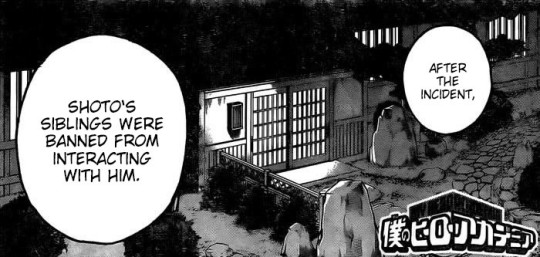
A+ parenting move there. “ho boy, our eldest just tried to murder our youngest, now what? hmm how about we isolate our youngest from all human contact”
though in their defense, we probably shouldn’t have expected this rabidly strength-obsessed fire man and his wife who was groomed since childhood to obey her family’s whims to have any idea of how to raise stable, well-adjusted offspring
SERIOUSLY YOU GUYS
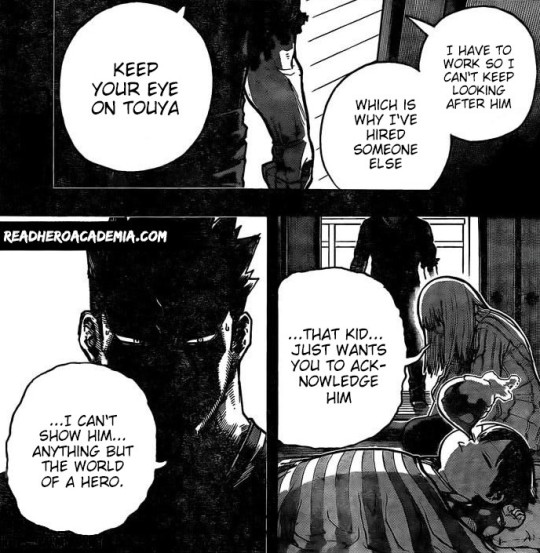
this is a perfect example of Enji’s tragically self-revolving viewpoint right here. just because being a hero is your entire world doesn’t mean you can just excuse yourself from anything outside of that and act like it’s out of your control. “alas, all I care about is hero stuff and my son can’t be a hero, we are doomed to inhabit two different worlds” no you jackass, it’s called having more than one hobby?? figuring out how to spend some time with your son that doesn’t involve training?? the same exact thing you were telling him to do last week, while ignoring that you’ve never done that yourself in your life??
that said, yet again we have that complexity though because it’s obvious that Enji at least on some level is aware of his own flaws, even though he seems unwilling or unable to confront them. honestly, from what we’ve seen so far, Enji’s obsession with surpassing All Might might be more accurately called an addiction. he literally can’t let go of it even though he’s fully aware of how it’s slowly destroying his life. and so in the same way that a lifelong smoker or alcoholic might tell their child to stay away from cigarettes and booze, Enji tells Touya not to follow down the same path as him, even though he himself doesn’t know how to leave that path. so yes, it’s hypocritical as fuck, but there’s also an element of helplessness there as well because Enji literally doesn’t know how not to be like this
though all the same he sure could stand to put in more than just a token effort. but it is what it is, and we already know how much he’ll come to regret it
and meanwhile Baby Shouto has frozen his sleep bubble with his quirk lmao. so I guess his quirk did come in early. that’s a recipe for chaos right there
once again Shouto is ruining every single dramatic panel in this flashback

this was so dark and intense... and then I spotted the lil bubs in the corner. Horikoshi please control yourself
“some hero you are, running away” and then all of a sudden, “FIVE YEARS LATER” lol what. OKAY THEN
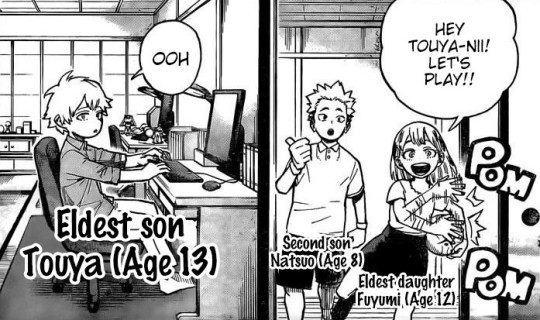
(ETA: love the confirmation that eight-year-old Natsu comes from the Iida school of puberty and is basically a fully grown man, and meanwhile Touya comes from the hobbit school of puberty and has been perpetually eight for the past five years.)
“HEY BIG BRO WANNA COME RECREATE AN ICONIC FLASHBACK SCENE WITH US. WE’VE GOT THE SOCCER BALL RIGHT HERE, BUT HURRY UP OR WE’LL BE TOO LATE FOR SHOUTO TO WALK ON BY AND STOP TO LOOK”
lol and that’s literally the next three panels. but Horikoshi did add this extra bit after Endeavor starts to drag Shouto away
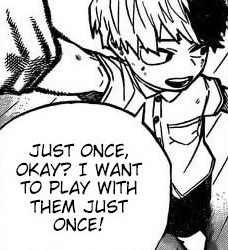
seriously Enji what the hell did you expect was going to happen here. “Touya went nuts and tried to kill his little brother out of jealousy, so let’s make it clearer than ever that Shouto is the important child and all the other children are just rejects. this will definitely not make the problem 100x worse, and will surely lead to Touya giving up and living a happy life, having been emotionally abandoned by the person he admired more than anyone.” good for you pal you figured it all out. no need for that plan b, “we all just go to therapy”
anyway so he’s telling Shouto he can’t play because he needs more endurance training. and meanwhile Touya’s patented Todoroki Drama Genes are going through puberty as well
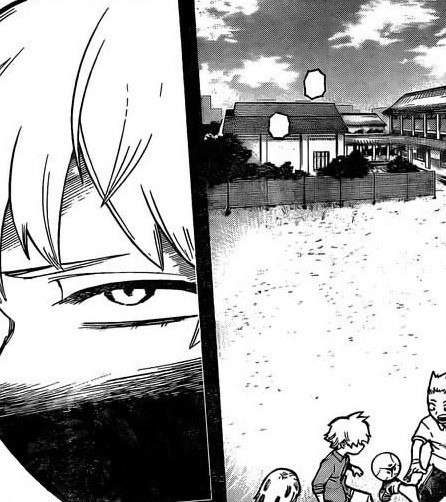
definitely the face of a happy, emotionally stable child who’s not still plotting to murder his younger brother in his sleep
“WELL ACTUALLY MAKESTE” lol I stand corrected??
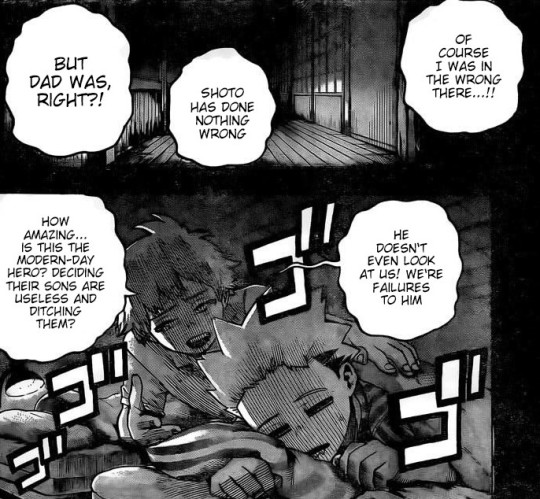
apparently during the five year interim Touya actually stopped blaming Shouto and realized Enji was the one at fault. good for him! a bit inconsistent, given what we know happens later, but I assume we’ll get to that in good time
anyway. “yeah man I agree that dad sucks, but it’s the middle of the night and I’m only eight and you’ve been monologuing for the past two hours bro”
LMAO
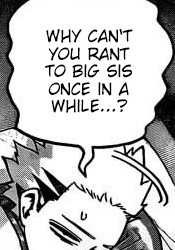
the manga is making my jokes for me, only better. fine then
looks like someone’s still miffed about that disagreement he had with his baby sister back when she was like four
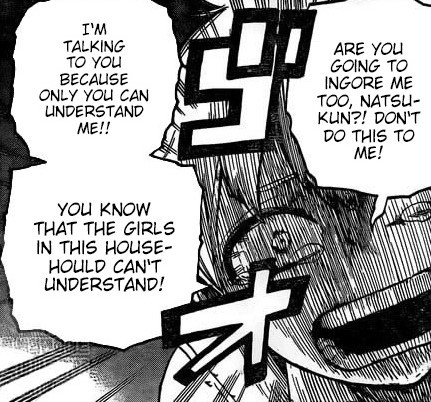
“Fuyu doesn’t get properly riled up like I want her to so ranting to her is annoying.” okay but having been in Fuyu’s shoes, it really is just a different way of coping, and I can guarantee she’s not as fine with the whole situation as Touya might think. but making your peace with something is often a decision that’s made for emotional self-preservation reasons. and I sure as hell don’t fault her for trying to shut out a situation that she had no control over, and trying to make the best of it, and scrape together as normal a childhood as she could manage
and now in Touya’s defense as well, that is of course easier said than done, and I’m sure if there was a “push this button and instantly get over all of the trauma in your life” switch readily available for Touya then he would have pushed it too. unfortunately it’s not always that simple
so now Rei is pleading with Touya not to go train up on his little emo hill again, but it doesn’t seem like much has changed since he was eight

I don’t think he gives two figs about being a hero; he just wants his father to look at him again with pride. fucking hell, stop doing this to me you damn Todorokis
guh, they keep telling him the same thing over and over again
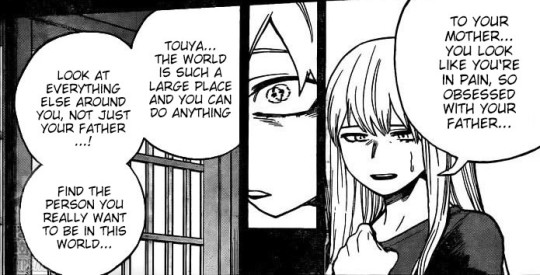
even if we hadn’t already known he was gonna go melt his jawbone off soon, I wouldn’t have expected a line like that to go over well
yep. fuck
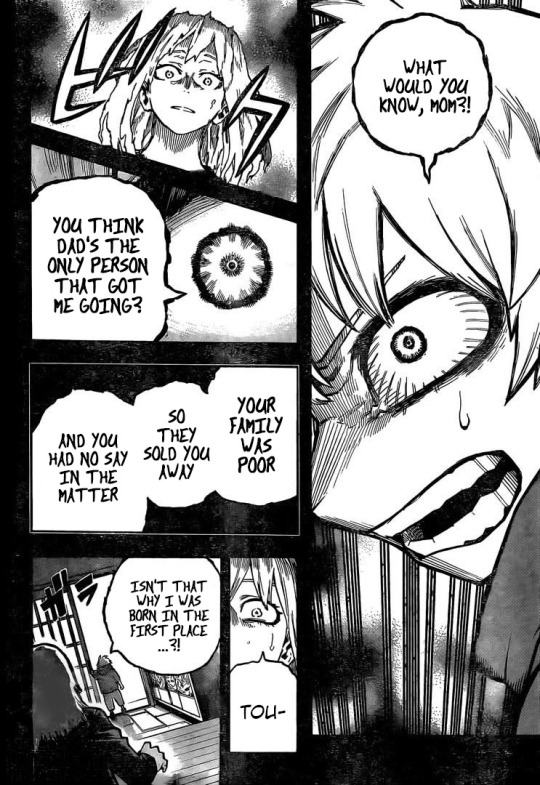
that Todoroki puberty angst, though. nothing else quite like it
“you have a part in this too, Mom” ooooooh man
okay but look, he’s not entirely wrong. like, I’m not saying any of this is Rei’s fault at all! she’s in an impossible situation where she’s afraid to stand up to Enji (who by this point has shown that he’s willing to physically attack her if things get too heated, which is terrifying), and doesn’t really have anywhere to turn for support. her parents aren’t helping much if at all, and Japan in general is just a terrible country to be in when you’re in a domestic abuse situation. everyone’s expected to put on a brave face and deal with their problems all on their own in private. Rei is basically completely isolated at this point, and she doesn’t know what else to do, and so she’s just trying to keep the situation as stable as possible for the kids
but on the other hand, “for the kids” is also where that argument starts to break down a bit, because at this point Shouto is also being physically abused by his father, and the other kids are continuing to be neglected (emotionally if not physically), as they have been for years. so the situation really isn’t stable at all for them. and as a kid, what you end up learning in that type of situation is that you can’t rely on either parent. not the abusive one, certainly, but also not the other one who can’t protect you from any of it. even if they love you and they’re trying, they’re just as helpless as you. Rei is struggling to deal with all of this with one hand tied behind her back, and I get it, and I’m not blaming her at all. but all the same, particularly given that she’s (understandably) putting almost all her focus on Shouto, the end result is that the other kids have basically been left to fend for themselves
so yeah! a shitty situation all around. and one of those cases where it’s not really anyone’s fault (aside from Enji’s), but I can understand the resentment Touya is feeling all the same. and I’m so glad Horikoshi is acknowledging this, because it’s something I probably would have been too uncomfortable to bring up otherwise. as it is it’s still an incredibly heavy subject, and one that I probably have too many personal feelings about
anyway, so once again the whole “we’ll try talking to him and then just shrug our shoulders when it doesn’t work” parenting strategy doesn’t really pan out for the Todoroki fam
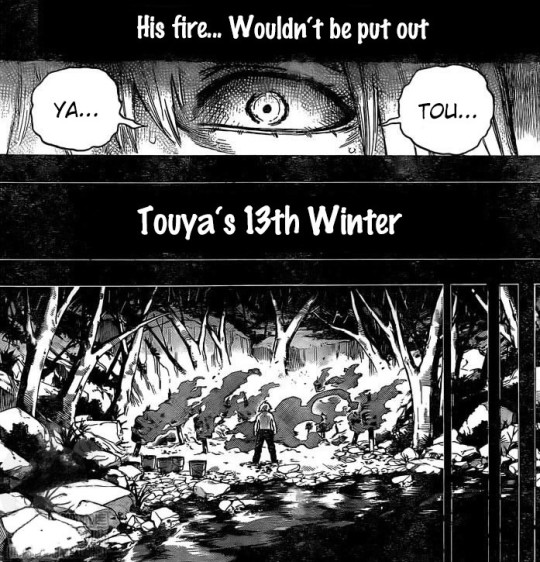
sob this boy is Anakin Skywalkering before our very eyes. all that’s missing is AFO to come and start whispering in his ear. any minute now...
“anyway so then he got taller and his fire changed from red to blue”
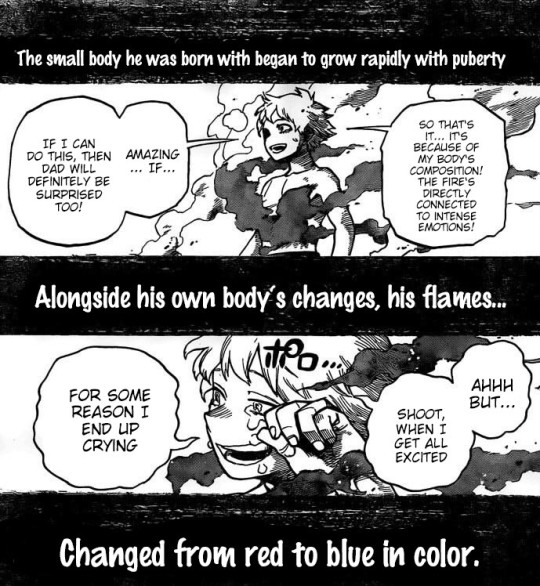
guess we’re getting pretty close then huh. this is the part of the flashback that I really don’t want to see, but also unfortunately the part that I’m most curious about :/
oh for fuck’s --
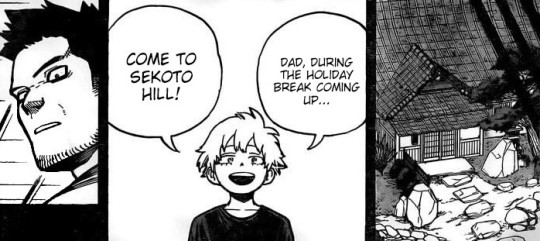
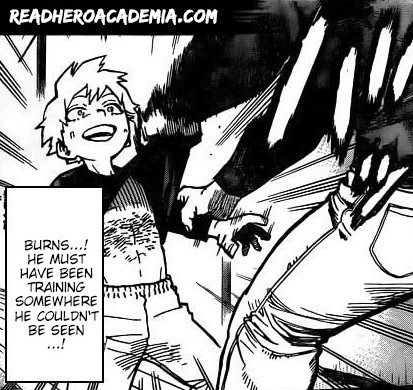
“WHAT DO YOU MEAN IGNORING HIM FOR FIVE YEARS DIDN’T ACTUALLY DO ANYTHING TO SOLVE THE PROBLEM” sob. back to the drawing board I guess
I thought he got taller, why is he still only like a third of Enji’s height here
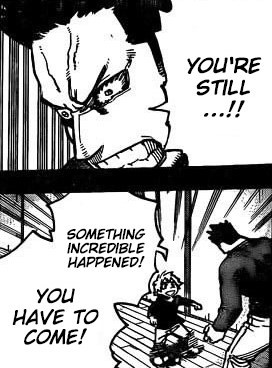
oh fuck me these are armor-piercing feels. this is the heavy artillery right here

ENJI I’M BEGGING YOU PLEASE STOP AND THINK FOR ONE MOMENT IN YOUR LIFE BEFORE DOING SOMETHING YOU’LL REGRET FOR THE REST OF ALL TIME. your child just told you that he still thinks beating All Might is the only thing you care about, and that he believes his existence is a mistake unless he finds some way of doing that for you. please stop for a moment to contemplate that and choose your next words with care and grace and oh who the hell am I kidding
-- OR WE COULD JUST BLAME REI
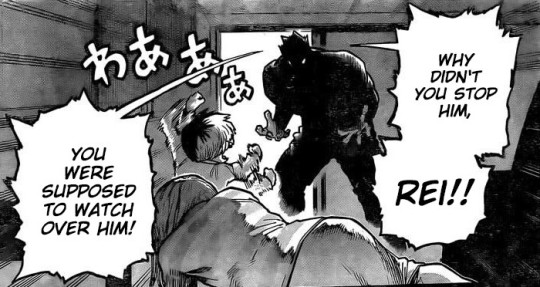
go on and blame everyone but yourself then!! that’s a great solution!! jesus christ man I know this is Endeavor at his literal worst but still this is fucking hard to watch
POOR BABY SHOUTO IS YELLING AT HIS DAD NOT TO HIT HIS MOMMY THIS LITTLE BRAVE BOY NEEDS SO MANY HUGS OH MY GOD
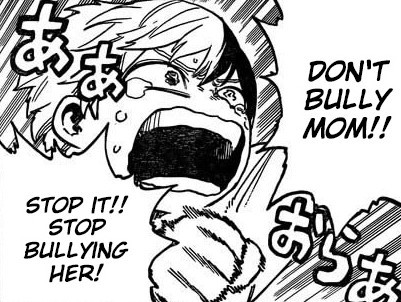
AND MEANWHILE THE OTHERS ARE HUDDLED IN THE NEXT ROOM TRYING NOT TO CRY AH FUCK

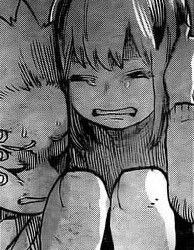
(ETA: Fuyu covering Natsu’s ears cuts RIGHT TO THE CORE OF ME. Horikoshi if you’re really not gonna get these kids some therapy then at least consider giving your readers some. what is this.)
you know it’s bad when you’re starting to think the part where the kid burns to death might actually be a less traumatic thing to cut to right now
holy shit, actual Rei thoughts
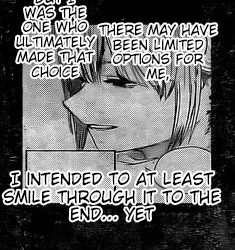
“I was the one who ultimately made that choice” well there we go, wonder if that’ll put that whole argument to bed at last. I doubt it, but you never know. actually who am I kidding it’s not gonna settle jack shit lol
oh thank god, they decided it was getting too intense and cut away back to the present to narrate this next (final?) part

get ready to cue up that Alicia Keys. THIS BOY IS ON FIREEEEEEE
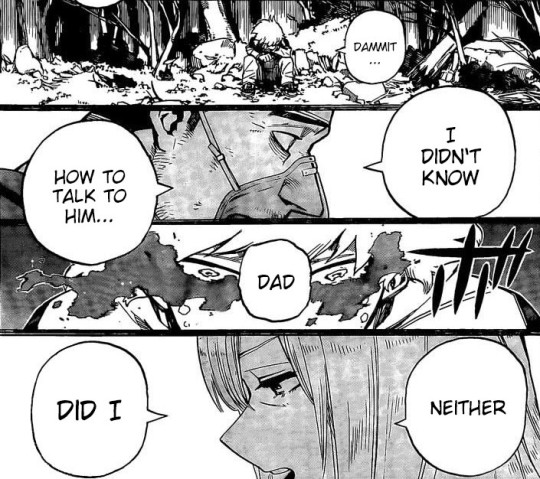
yeah I think that’s one thing we can mostly all agree on. neither of them had any clue what the fuck they were doing pretty much at any point. though I will say that the hypocrisy of him being all “WHY DIDN’T YOU STOP HIM” followed by him IMMEDIATELY DOING THE EXACT SAME THING is a bit rich
(ETA: and he still has this problem, doesn’t he? he froze up when Ending snatched Natsuo, and again when Dabi was attacking Shouto. he’s so afraid of doing the wrong thing that he ends up not doing anything, which of course is exactly what led to Touya’s death. damn Enji I guess you’ve still got some additional character development to unlock.)
and of course neither of them could possibly have known how badly it was going to turn out. like, the consequences here were WAY disproportionate even for the shittiest of parenting. no one expects “I didn’t know how to talk to my son” to snowball into “my son burned to death and then somehow came back as a villain and murdered thirty people”
ohhhhhhhh fuck me
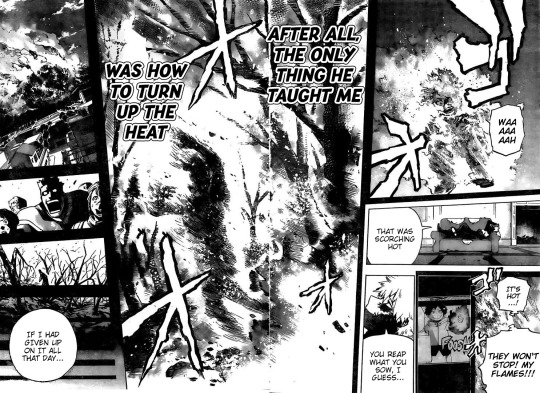
LITERALLY INCINERATED THE ENTIRE HILLSIDE. fuck. and I am so not ready for the scene of Enji finding the remains of his jawbone afterwards. at least we were spared anything super-graphic (for now at least)
I feel like the timeline here is off, btw?? wasn’t Touya’s death supposed to happen after Rei got hospitalized? this might be the first actual retcon of the entire flashback. although I think it makes more sense this way tbh
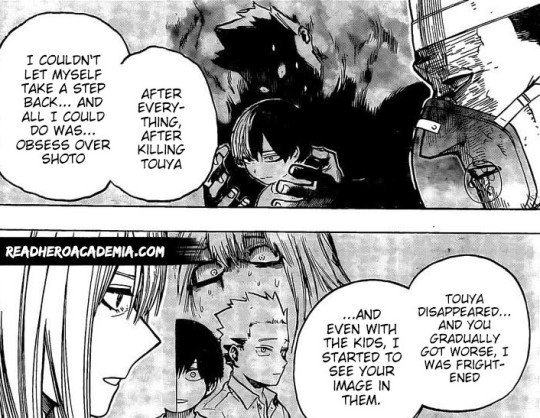
I do appreciate that ten years later Enji is finally reflecting on the fact that if he’d just given up his stupid obsession he could have stopped his family from crumbling apart. that probably sounds sarcastic as fuck, but it’s not. there are countless jerks out there who would have still managed to find a way to blame literally everyone and everything under the sun except for themselves. at least he finally figured out how to take responsibility, even if it came too late to stop his son from dying and being radicalized into a villain terrorist organization
and speaking of, it seems to me we’re missing a third and final part to this little tale of woe, and one which only Touya himself will be able to shed any light on. so we’ll see how that goes
oh man seeing the other kids blaming themselves even though none of it was their fault hits hard af. Rei wasn’t kidding when she said they’d been bearing that burden of guilt far longer than Enji
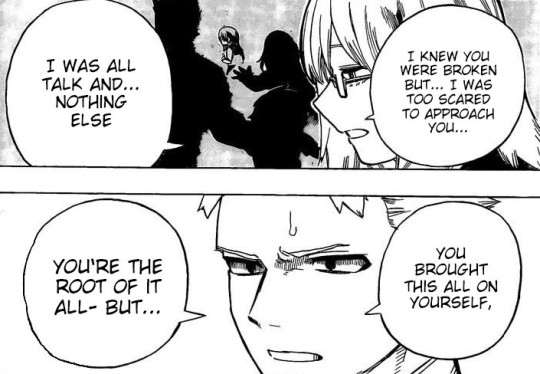

SHOUTO I SWEAR TO GOD IF THE NEXT PANEL IS YOU APOLOGIZING FOR BEING BORN, I WILL... WELL I’LL BE VERY SAD, I GUESS. SO DON’T DO IT
oh good he’s just being quiet. good. it absolutely is not your fault lil bean. it’s not theirs either, but feeling guilty about things that aren’t your fault is a time-honored shounen tradition
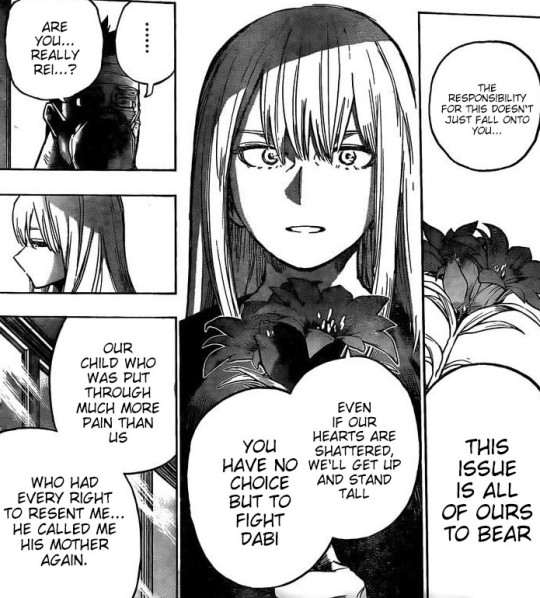
goddammit I braced myself for the angsty Shouto panel a page too early. gotta do it all over again now lol. okay here goes
;_;
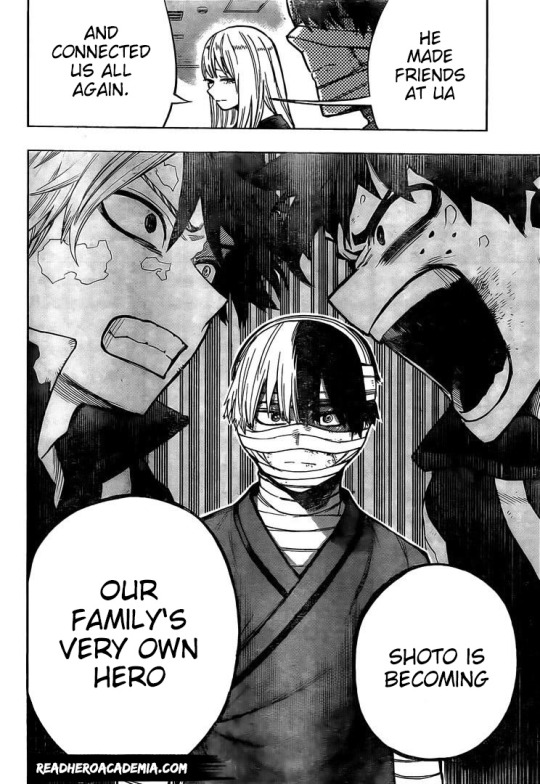
well well well would you look at that

imagine that. talking things out with your child before they make a rash decision. looks like the Todorokis’ parenting skills are finally leveling up
OH MY GOD
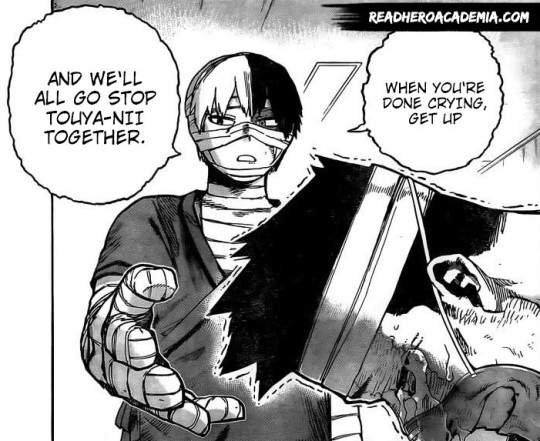
holy shit. this is the most quintessential moment of father/son Todoroki bonding in the entire series. for me it even tops the “nice scar” scene lol. Enji sobbing at the fact that he still has a chance to set things right. and Shouto offering his hand in what is actually the most mature and selfless gesture I’ve ever seen, and being all “we’ll stop him together” to his dad who he hates, but also doesn’t really entirely hate anymore. and all of that is incredibly moving... BUT ALSO HE STILL REFUSES TO MAKE EYE CONTACT WITH HIM AND HE WOULD LIKE HIM TO STOP BEING SO FUCKING DRAMATIC ALREADY IF YOU DON’T MIND. “WHEN YOU’RE DONE CRYING...” fkjldsk
OH MY FUCKING LORD
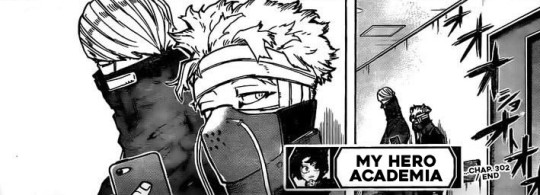
(ETA: wouldn’t be a Todoroki drama fest if there wasn’t somebody listening in on the whole thing in secret just around the corner lmao.)
“you think we should have waited somewhere else?” “yeah, probably.” “are you feeling a lot of secondhand embarrassment too?” “god, you have no idea.” STFU HAWKS IT’S NOT EMBARASSING TO BE MOVED TO TEARS BY YOUR FAMILY ALL COMING TOGETHER IN YOUR DARKEST HOUR TO GIVE YOU HOPE THAT YOU PROBABLY DON’T DESERVE BUT ARE NONETHELESS INDESCRIBABLY GRATEFUL FOR
and anyway you chose these guys as your found family, bucko. too late to back out now. next time go get yourself adopted by the Iidas then
AND MEANWHILE NO WORD ON THE WHOLE “HOW DID A THIRTEEN-YEAR-OLD SURVIVE A FIRE THAT COVERED HIS BODY WITH HORRIFIC SCARS AND MELTED HIS JAW OFF, AND HOW DID HE SOMEHOW THEN MANAGE TO GO INTO HIDING FOR TEN WHOLE YEARS, AND WHAT HAPPENED IN THAT INTERIM TO CHANGE HIS GOAL FROM ‘SURPASS ALL MIGHT TO IMPRESS MY DAD’ TO ‘KILL ALL HEROES TO MAKE MY DAD SUFFER’.” as if we don’t know the answer to that. but still, would it kill Horikoshi to just confirm AFO’s involvement in all of this already. at this point it’s basically just a formality
so here’s hoping next week we’ll either get that, or more Hawks action, or (DARE I EVEN SUGGEST, I’M AFRAID TO JINX IT) finally cut back to Bakugou and Deku and All Might omg. either way I’m hyped
#bnha 302#todoroki touya#dabi#todoroki enji#endeavor#todoroki rei#todoroki shouto#todoroki natsuo#todoroki fuyumi#bnha#boku no hero academia#bnha spoilers#mha spoilers#bnha manga spoilers#makeste reads bnha#my sincerest apologies for this absurdly long recap which is barely funny at all!#THERE WAS VERY LITTLE HUMOROUS CONTENT IN THIS CHAPTER#congratulations horikoshi you win this round
471 notes
·
View notes
Text
Let's Talk About NatsuMikan: The Anime (pt. 1)
I could go on and on about these two and I think I will, just because I don’t often see people talk about the analysis behind them. The meta I have seen about them has included a perspective that equaled the anime and the manga and I don’t think that’s an accurate way of viewing their relationship.
The anime is a different species than the manga, something that frequently happens during the adaptation from page to screen. Since they’re so different, I’ll analyze them separately.
There's going to be many parts to this so I'll keep a table of contents right here so people can more easily navigate (though you can also read through the "let's talk about natsumikan: the anime" tag on my blog):
Anime Analysis
Part 1: Exposition & Episode 7
Part 2: Episodes 8, 9, 10, & 11
Part 3: Episodes 12, 13, 14, 15, 16, & 17
Part 4: Episodes 18 & 19
Part 5: Episodes 20, 21, & 22
Part 6: Episodes 23, 24, 25, & 26 & Conclusion
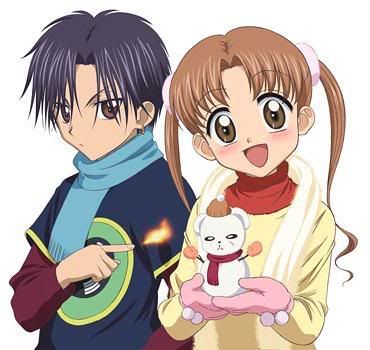
The anime makes changes, as anime adaptations often do. The most outstanding changes are appearance related, as Natsume now has brown eyes instead of red, in addition to other characters who have hue-shifted eyes and hair. But there are also story changes, and I’ll be focusing on the changes that occur, specifically in regards to Natsume and Mikan and their relationship.
For one, their relationship starts evolving much earlier in the anime. I think it’s pretty undeniable that in the anime, Natsume started liking Mikan at the end of the dodgeball game. That scene never happened in the manga, but in the anime, it’s a crucial step in making sure nothing seems too sudden or forced.
The anime is 26 episodes long. If Natsume only starts liking Mikan after she saves him during the Reo Arc, then we’re already halfway through the show when positive feelings between the two appear. On the other hand, the feelings develop more slowly in the manga because there’s more time to properly develop the relationship in a more drawn out way.
My analysis will start with the anime, because it’s shorter and easier to discuss.
Exposition
It’s impossible to say that the anime was completely loyal to the manga. It very frequently couldn’t be, because it needed to fill in time in episodes or give closure early before the manga even addressed it (Natsume’s backstory in the anime, for instance, is vaguely referred to and implies deviation from the manga).
The most obvious difference between the manga and the anime from the get-go is visual. Not only do they have differing art styles (I don’t dislike the anime style but Higuchi Tachibana’s art style is so distinct and unmistakable while the anime’s isn’t so unique), but the setting is also different.
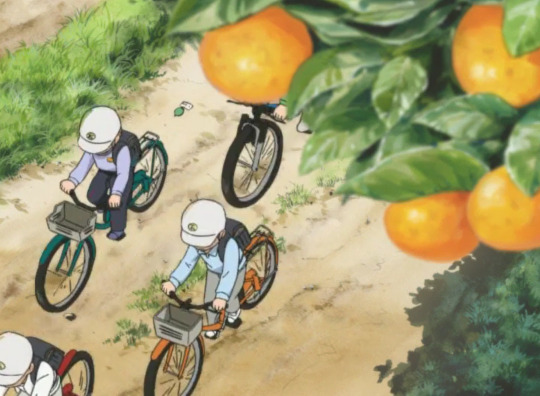
While the manga started in the depth of winter, the anime starts off in summer/fall. It always struck me as odd that while the first page of the manga has Mikan running after Hotaru in full winter-wear, the anime starts off warm and idyllic. You could almost think of that as a general warning for the difference between the anime and the manga. After all, while the anime has a reputation for being a cutesy and upbeat story about friendship and magical powers, the manga is much darker and discusses many morbid and depressing themes that can and WILL fuck you up. Warm vs. cold seems like an accurate difference, though I don’t think that was intentional.
We see way more of the village life in the anime, including Mikan’s efforts to keep the school from closing. This is a welcome change because Mikan’s passion to keep the school open is nothing compared to her friendship with Hotaru, and even after the school is saved, she runs away to see her friend, even if it means she goes to another school. The manga doesn’t imply that Mikan knew already about the school’s fate, and since she is always so preoccupied with Hotaru anyway, we don’t really get the impression that she cares very much. To Anime!Mikan, Hotaru is more important than saving the school, something she was so passionate about she rallied to get signatures. It’s an extra scene to prove just how much Hotaru matters to Mikan, and to show even more how selfless Hotaru was to go to Alice Academy, since she knew how much the school mattered to Mikan.

“Sign my petition to get a Gakuen Alice anime reboot!!!”
My boy Natsume is only introduced properly in the second episode, when we actually see his face and he speaks. His appearance is different from the manga’s too. I’m not sure if this was to appeal to a younger audience or what, but Natsume’s eyes are changed to brown instead of their iconic red, something that was always my biggest peeve about the anime adaptation. His hair is also somewhat purplish instead of entirely grey/black and, although this does bother me a lot less than the eyes, I wonder why they made this change when other characters have black hair. It might have been to differentiate him from Hotaru, another main character with black hair, though I’ve never had issue in the manga telling them apart.
His first interaction with Mikan is a lot more pleasant in the anime than in the manga, although that’s not really saying anything. Mikan’s skirt simply falls off and Natsume draws attention to it, rather than the unpleasant events that took place in the manga. This different event makes it a lot easier to support a relationship between the two of them right off the bat. They are still antagonistic but it’s not as terrible as it is in the manga. This makes it easier to establish romantic feelings earlier on, and might have been changed in order to achieve just that, or possibly also to appeal to a younger audience. Maybe both? Who knows.
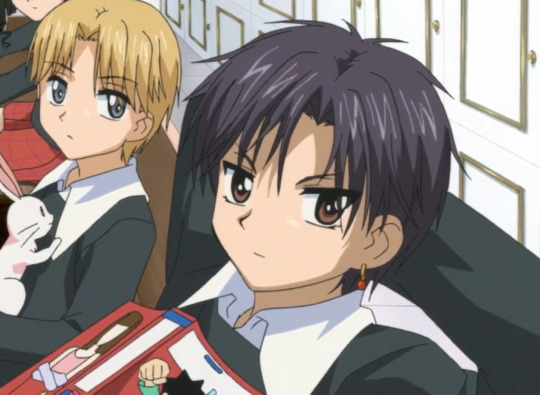
“You can’t sit with us!”
With Natsume presented the way he is in the anime, it’s easier to make the claim that he’s simply a good guy who acts the way he does to protect people. And it’s true! He is! But he is also so much more. In the manga, he’s a more complicated character. Although he is a good person, he still requires character development, which is something he does go through, and something I’ll talk about more in his meta analysis later.
Most of the events at the beginning of the anime parallel the events of the manga. Mikan goes to Alice Academy at the same time of year, Natsume shows up with an explosion, Mikan has to go through the Northern Woods, she discovers her powers in her fight with Natsume, etc. Some of the continuation from episode to episode is different than the transitions between chapter to chapter, there’s extra scenes inserted to fill up time, and some of the exposition seems strangely presented (in the anime, Mikan finds out more about the school when she finds Narumi and Iinchou waiting for her at a tea party, which is…. Super weird…), but all in all the information and events are mainly the same. The big differences start with the dodgeball episode.
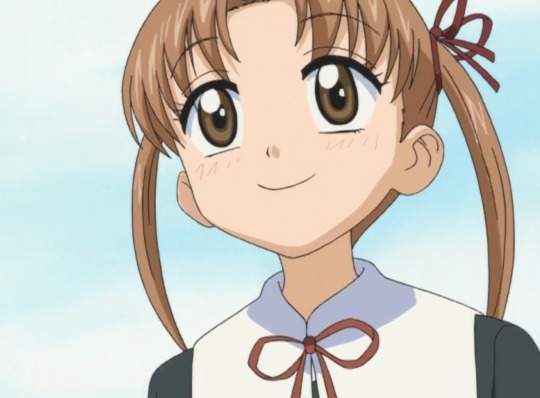
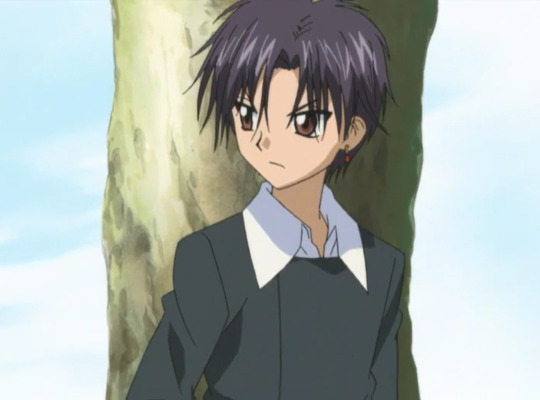
“Look how happy she is. Makes me wanna barf.”
Episode 7 vs. Chapter 9
I love the dodgeball episode. I feel like for the most part, the anime does deviation from the manga pretty well. With the last arc as an exception, I generally enjoy their changes and additions to the plot. The anime has to be different, has to progress at a different pace, has to introduce topics at different times. They have an episode to fill, and less time to build relationships. Natsume and Mikan are both different characters in the anime but it’s very subtle and has to happen due to the fact that the anime is shorter and seems more designed for younger audiences, in addition to wrapping up before the manga could explore more of the story.
Anyway, let’s talk about the dodgeball episode. AGAIN THIS DOES NOT HAPPEN IN THE MANGA THE SAME WAY so when discussing NatsuMikan as a concept, the anime events cannot be treated the same as the manga events. A lot of people maybe forget that the manga is very different than the anime when it comes to this episode. I see the two media conflated in plenty of fanfics, where seventeen year old NatsuMikan reflect on the dodgeball game from their youth that changed everything, and I get it because the anime version of the dodgeball game is cute! It's shippy! It's fun! But it doesn't happen in the manga the same way.
There's a similar trope with the sakura tree, which I can only remember from the anime, and yet it's such a fundamental aspect of NM fanfic it might as well have played a vital role in both anime and manga. Nothing wrong with any of this, of course. I'm just making it clear that my analysis will cover the two media as separate for the sake of a cohesive essay. Separating them in fanfic is far less important.
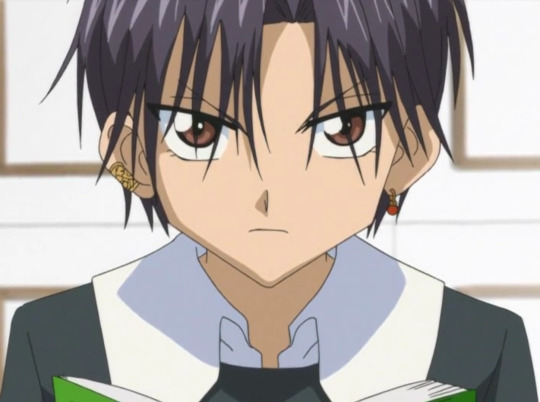
This look could probably kill someone. I’m surprised Mikan is still alive, TBH.
The chapter’s focus is Mikan starting to feel more at home in Class B, making friends with her once-hostile classmates, but the episode is more preoccupied with Natsume and Mikan’s perspectives on each other. While in the manga, the game ends with a tie and Mikan accidentally hits Hotaru in the face with the ball, the anime draws out the game to fill an episode and to introduce an evolution in the way Natsume sees Mikan. The first part of the anime episode is Mikan introducing her friends to her new senpai, Tsubasa. After she invites her friends, we see Natsume glowering at her and promptly ditching the next class, saying to Ruka that he can’t stand being in the same class as her. This addition to the plot already foreshadows that their relationship will change in some way by the end of the episode.
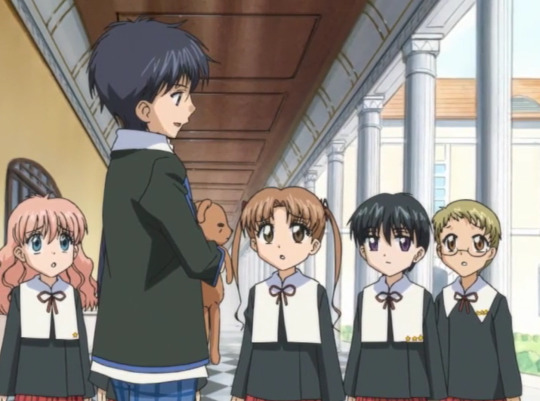
Tsubasa tells a frustrated Mikan that if she wants Natsume to be less unpleasant, he’d need to release some of his toxic energy. Thus, the sporty Mikan introduces the concept of dodgeball to the unwelcoming class. When they finally agree, Natsume gives one condition: that they play with the notorious Alice Ball, which is powered by the thrower’s alice (a detail absent from the manga). This Alice Ball is particularly terrifying with the threat of Natsume’s dangerous fire alice. Mikan also needs to get more people on her team, another aspect absent from the manga. While in the manga, Mikan only had her few friends on her team (including a wandering Ruka) and this ended up playing to her advantage, the anime has a humorous plot of Mikan tracking players down for her team, including a fake mustache she makes with her pigtails (she’s so cute, I love her), paying Hotaru to be on her team, and blackmailing Ruka to participate. This was mainly to fill time, but it makes the dodgeball game more important as well.
In the manga, we don’t see how the game ends, just that the teams tied and that everyone in class is having fun and bonding. In the anime, more emphasis is put on the “Mikan vs. Natsume” aspect, so a tie like the manga’s would be anticlimactic. Thus, the anime concludes the dodgeball game with Mikan and Natsume being the only kids left on the court, and Natsume not using his alice when he throws the Alice Ball. Even Hotaru leaving the game is something she does out of boredom instead of injury, further separating the other characters from the plot. It’s about Natsume and Mikan, and everyone else is mostly a side character. (Though Ruka also plays a vital role to this episode AND chapter, and it’s at this point that I think he started developing real feelings for Mikan as well. So when it comes to the anime, he and Natsume fall for Mikan around the same time, but in the manga, Ruka likes her first and the “he liked her first” argument for Natsume vanishes, though he never had that “advantage” to begin with.)
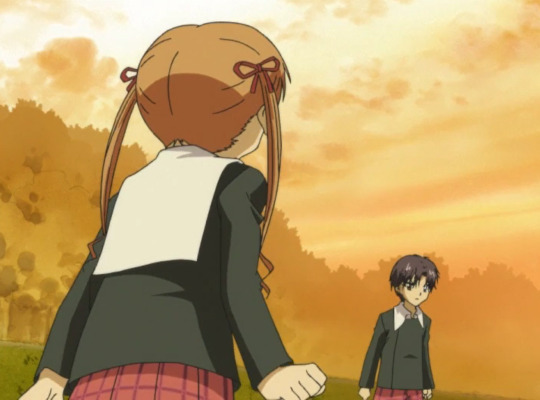
“Thank you!”
Natsume wins (something that shocked me at twelve years old) and is ready to walk away with his handy “tch” and all but Mikan thanks him for not using his alice and he goes off on her, demanding to know why she’s still smiling despite her loss. She says she’s happy that he had fun and was involved with the rest of class for once, and that in a way that means she wins. For Anime!Natsumikan, this is it. This is the turning point. “I just wanted you to be happy and have fun,” is what Mikan might as well be saying. “Really, this was all for you!” It’s sweet and it’s thoughtful and I don’t think Natsume ever imagined he’d be on the receiving end of her kindness, especially after all their beef. Manga!Mikan would probably not say these things to him, even if she meant them, for the sole reason that Mikan is stubborn and holds onto her pride, especially when it comes to her early relationship with Natsume, but Anime!Mikan is much more forgiving and much more willing to extend an olive branch, like in the dance episode. In any case, Natsume starts falling right then, and it’s obvious too, because he is pissed, and even more angry because he’s not even mad at her. He’s angry with himself for his change of opinion. This is the girl he was fully content to hate forever and yet here he was, starting to like her. Not ideal.
This scene, something so crucial to the development of Anime!Natsumikan, is completely absent from the manga. In the manga, Natsume still dislikes her by the end of the game although he does have fun.
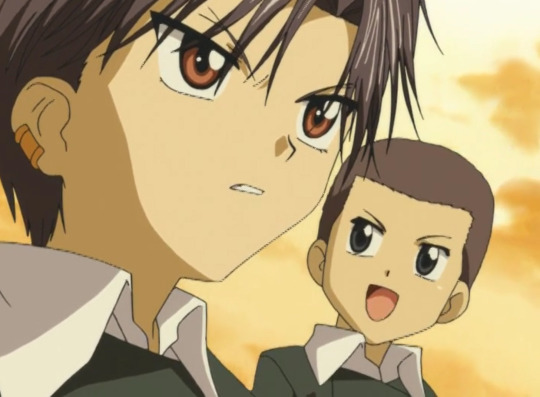
He's not angry, just disappointed. In himself.
I’m not going to say one is better when it comes to starting up NatsuMikan because they’re very different creatures and I actually thoroughly enjoy both.
Anyway, the NatsuMikan after episode 7 is almost the same as in the manga, but the events carry a different weight since we know Natsume likes Mikan now (even if he would never admit it).
Summary
I hope this first part was interesting, and that it introduced the idea of Anime!NatsuMikan as being a little different from the manga's version. Yes, it is more or less the same story, but with so many thematic and plot changes, they take a different form as well, in a perhaps more subtle way, kind of like a slightly canon divergent fanfic. Fanfic where Natsume starts liking Mikan a bit earlier on in the story.
Next Part ->
#gakuen alice#alice academy#natsumikan#hyuuga natsume#natsume hyuuga#sakura mikan#mikan sakura#meta#my meta#ga#meta analysis#mine#ga meta#ga meta: anime nm#let's talk about natsumikan: anime#im trying to create a system from one post so let's see how it goes#ive never posted media analysis like this but im very excited to bc ive always wanted to analyze these kids <3#unfortunately due to tumblrs image post limit of 10 i had to split this into MANY parts#im a visual person and i know others are too#if these images are not sufficient then i would rec maybe rewatching the eps after reading or maybe just skipping through the eps#u might some find some changes and themes of note as well to add and that would be super fun!#ga meta: nm#let's talk about natsumikan
53 notes
·
View notes
Note
look im not planning on like, stalking you and sending an essay refuting every radfem or radfem-adjacent post you rb. that would be patently ridiculous and i'll most likely just unfollow but regarding the "surrender linguistic boundaries" thing... what on earth is the point in that? thats just (broadly) a compilation of people talking about folks who can get pregnant. yeah theyre like, really clumsy about it- plenty of conservative women are anti-abortion and frankly are just as ghastly about it as conservative men. tons of horror stories about pro-life nurses actively traumatizing people who miscarried and had an emergency procedure removing the dead fetus before it starts to rot them from the inside out. theres always going to be marginalized people who are also... kind of stupid and choose to be compassionless even when their own issues are rooted in the same source. the thing about those posts is that my guess is theyre still learning. i bet if you asked any one of those people theres a solid chance they would thank you for the correction and reword it. one of them looked to be about a specific individual desiring a surrogate(?) so refering to him as a man or a dad is fine. some of them are reductive or performative in that you can tell they still have that "ugh, men" mentality trained into them and havent questioned that yet and just labeled all nonbinary people as woman-lite. some of them use "men" because primarily cisgender men benefit from and cannot be hurt by forced birth and they didnt think to use the addendum of "not trans men/gay men/infertile men/pro choice men". whatever. nobodys perfect and even if they were, society is imperfect and so even then theyre gonna slip up sometimes, its fine.
now all that said, what even is a linguistic boundary??? "i just dont want other people using any of this specific terminology to more accurately describe affected demographics"? if its your linguistic boundary then like... dont use them. say "women" and people will understand your point entirely. maybe someone qrts with "*uterus havers" and you go about your day. cisgender women are little under half the global population i think we'll be fine. this is not at all an issue of erasing women, "pregnant people" even still defaults the average mental image to that of a woman. including trans men just... doesnt hurt anyone. if the health article headlines prove anything it is once again, as it so often is that trans women are erased. really the only issue with those examples isnt that theyre denying that women exist its that they use "men" and dont elaborate. transphobia is the current default state of society, and i dont see the point in cisgender women rallying themselves against an already marginalized group when a) achieving transgender equality also hinges A LOT on gender equality between cis folks and b) even if trans people existing was a threat, we kind of have bigger fish to fry in the centuries of actual structural and societal oppression and those who uphold it. and in that the trans community can only be our allies.
if youre looking through radfem tags to see where your beliefs lie i would also reccomend "transphobia" or "cw transphobia". since transphobes arent likely to tag their bigotry as it is, thats where you'll find trans people talking about it of their own volition. those definitely get heavy so maybe "transphobia mention" if you want generalized discussion and not news articles about hate crimes. you'll also be more likely to find someone open to taking questions so long as youre in good faith and dont rock up to the first trans flag icon you see and like... harass some 18 year old stim blog about their stance on medical terminology.
I think you have a good point that maybe this needs to be a boundary I draw for myself and possibly not in general
I really do appreciate the tag recommendations. That really helps get aspects I wasn't able to view searching trans or trans ____
And this is maybe where it get controversial is that I see this language used to divide? Like are you here affected because of organs in your body? Then society sees you as x and you're captured here under this umbrella term because language is not precise.
But it also feels terrible to be reduced down to uterus haver and like . I never see it as testicle haver, never see legislation on that, or religious veneer using that. And I'm here talking trying to get what I'm missing and it's that language that is policed which is weird because I thought we were all stuck
I have been looking through more sources than just radfem blogs as I have been trying to inform myself. I can screenshot my search history if receipts are needed
2 notes
·
View notes
Text
FEATURE: Japanese Myths And How They're Depicted In Horror Anime
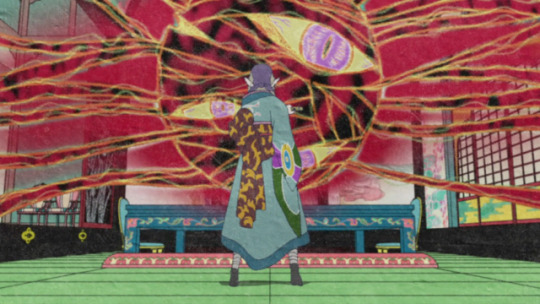
No matter the time or place, the folklore and myths of the past always persist. The same can also be said for anime, especially when it comes to horror. Certain franchises, such as Shigeru Mizuki’s classic GeGeGe no Kitaro, have solidified the omnipresent status of traditional Japanese folk monsters in popular culture. Other series, such as Osamu Tezuka’s Dororo interpret traditional folklore in relation to historical periods and changing attitudes toward religion. More recently, series from the 2010s and 2000s, such as Bakemonogatari and Ghost Stories, interpret the classics with modern sensibilities. When it comes to stories with a penchant for horror, it would be far more surprising if they didn’t allude to a shared supernatural mythology — the ubiquity is the point.

Neko-Musume on her smartphone
The best horror always tries to do something new. While creatures like yōkai (a wide umbrella of supernatural entities) are well-known among English-speaking fans today thanks to series like Yokai Watch, these re-imaginings always tend to play fast and loose with fidelity. Wouldn’t it be boring if every vampire movie started and ended with Dracula? In a 2016 interview with The Comics Journal, veteran manga translator Zack Davisson emphasizes this important tendency to re-contextualize old folklore:
“It’s a tricky question, as it is impossible to say what is ‘actual folklore.’ Vampires bursting into flame is considered ‘authentic,’ but that actually comes from the films, not folkloric sources. Folklore evolves and [Shigeru] Mizuki is an important part of that evolution. If you trace them back, most yokai we know come from Toriyama Sekien, who also just made things up. In fact, I would say that making up yokai is part of the grand tradition of yokai! If you are a writer/artist working with yokai and not making up at least a few of your own, you are missing the point!”
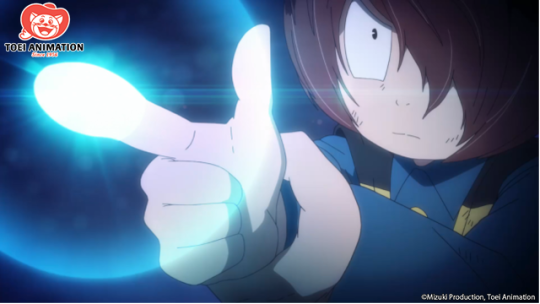
The original spirit gun
So that’s all to say — there really is no such thing as a definitive, one-to-one story based on centuries of tradition. Yōkai, as endearing as they are, are also just one part of the equation. Long-running anime such as Folktales from Japan and fantasy series Inuyasha-continuation Yashahime: Princess Half-Demon either re-tell or draw inspiration from that folklore. But that’s beyond the scope of this piece. Whether it be adaptations of urban legends about school bathrooms or vengeful spirits, I hope this round-up helps any casual or long-time anime fan appreciate how these series reimagine supernatural traditions.
Fantastic Folklore: GeGeGe no Kitaro & Mononoke
The late Shigeru Mizuki’s most influential character, Kitaro, hardly needs any introduction. In his book Yokai Attack! The Japanese Monster Survival Guide, translator Matt Alt describes yōkai as “the attempts of the fertile human imagination to impose meaning and rationality on a chaotic, unpredictable, often difficult-to-explain world.” Many yōkai are quite strange and sometimes even comedic. Scholar-artists, such as the previously mentioned Toriyama Sekien, are largely credited with inspiring their uncanny visual representations, making them the perfect subject matter for an accessible series.
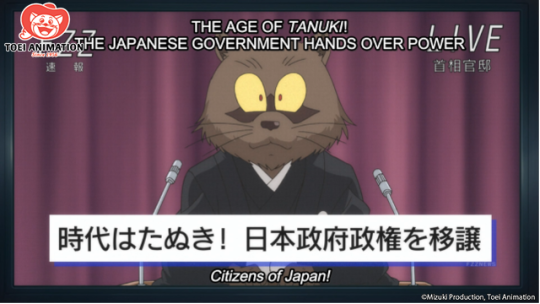
The tanuki plot world domination
The titular Kitaro himself is a half-human, half-yōkai one-eyed boy who travels between the human and spirit world to resolve monster-of-the-day conflicts with his friends. Although Mizuki’s Kitaro as we know it began serialization in 1960, Mizuki originally received permission to re-imagine the character from Masami Itō, who first created Kitaro in the 1930s in pre-war Japan. The most recent 2018 anime series re-establishes Kitaro in a modern setting, yet still adapts many of the most iconic stories. Characters such as Neko-Musume, based on volatile cat spirits called bakeneko, are updated with new designs while Kitaro mostly remains the same. Mizuki’s older creations, such as the jubokko (vampire tree) yōkai, are still featured alongside a new re-imagining of the “wall monster” nurikabe — inspired by the discovery of an Edo manuscript in 2007. The appeal of Kitaro isn’t so much the meticulous adherence to yōkai mythos, but rather Mizuki’s continual improvisation of the folklore-informed monster-making tradition.
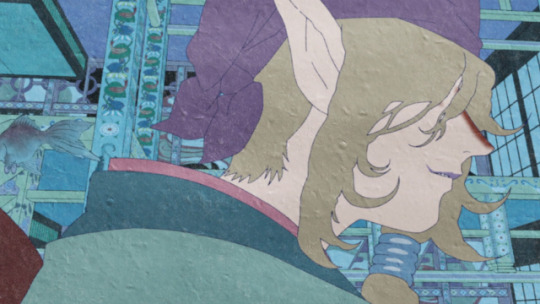
The Medicine Seller
Beyond Kitaro, other series, such as 2006’s Mononoke, dedicate entire storylines to a wider category of ayakashi (sea-bound yōkai) and funayūrei (boat spirits) written by none other than Chiaki J. Konaka. Later episodes feature bakeneko and nue (chimera monsters), but with a twist. The term mononoke itself refers to a variety of yōkai specifically referring to vengeful spirits possessing people or things. When it comes to series taking a more “fantastical” approach to folklore, both Mononoke and Kitaro thankfully never dissolve into simple rogue galleries of monsters — their (mostly) human protagonists largely remain the heart of their chilling saga.
Horror-Historical: Osamu Tezuka’s Dororo
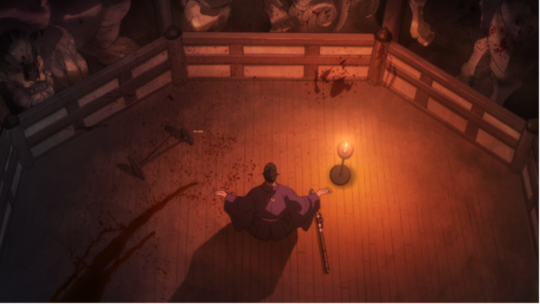
Lord Kagemitsu Daigo makes a pact with the demons (Source: Amazon)
In Anime and Its Roots in Early Japanese Monster Art scholar Zília Papp comments Mizuki’s “Kitaro characters became synonymous with yōkai in the postwar period, continuing to the present time” compared to his peers like Tezuka. But if Kitaro made yōkai big in comedic manga, then Tezuka’s short-lived Dororo manga drove this interest toward the historical context of the Sengoku Period, or the “warring states” era of feudal Japan.
Rather than depicting spirits as purely whimsical mischief-makers, Dororo’s inciting event is a feudal lord of the fictional Daigo clan forging a pact with 48 demons, who persist to hunt his son long after the pact is forged. In his feature The History Behind Osamu Tezuka’s Dororo, Marco Oliveros comments that by depicting yōkai during this period, Dororo draws inspiration from actual shifts in changing Buddhist attitudes toward these entities:
“One of the foremost examples of this change to yokai is the tengu. Wrathful and demonic, the avian creature tricked and assaulted Buddhist clerics and civilians alike, becoming characterized as the sworn enemy of Buddhism. The apparent hostility of these yokai to Buddhism makes their dark deals with Dororo's Daigo an unsurprising turn of events for the Sengoku Jidai era.”
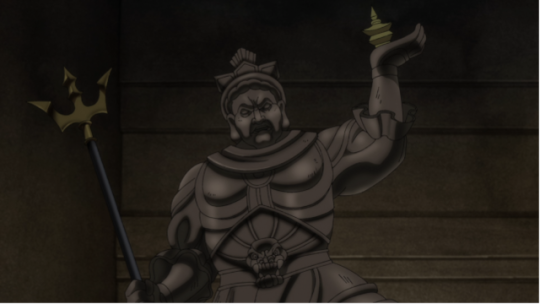
The Amanojaku is captured and sealed inside a Buddhist temple (Source: Amazon)
Matt Alt’s 2016 translation of Japandemonium Illustrated: The Yokai Encyclopedias of Toriyama Sekien describes the tengu (mask-wearing entities usually depicted as half-man half-bird) as “deeply associated with the religion of Shugendō,” which originated during the Heian period; however they were depicted very differently in major Buddhist sects of the same era. Unlike solely “fantastical” stories of the supernatural without much acknowledgment to historical context, Dororo is interested in this context regarding capricious attitudes of spirits of people alike. Impressive malevolent entities such as kyūbi (nine-tailed foxes) also fight against Dororo’s protagonist, Hyakkimaru, typical of supernatural jidaigeki (period drama) horror stories set in feudal Japan.
However, Dororo also features lesser entities such as amanojaku (tiny, goblin-like demons). According to the influential illustrated encyclopedia Wakan Sansai Zue compiled by Sekien-predecessor Terajima Ryōan, amanojaku and tengu were described as paired descendants of the evil goddess Amanozako (literally "tengu god"). According to scholar Haruko Wakabayashi in The Seven Tengu Scrolls: Evil and the Rhetoric of Legitimacy in Medieval Japanese Buddhism, tengu were symbolically invoked in inter-personal and religious feuds amongst Buddhist sects during the Heian period. The amanojaku depicted in Dororo is minor. But with a (simplified) understanding of its affiliation with tengu’s pre-Heian origins and its subsequent disavowal by influential Buddhist sects, Dororo's amanojaku cameo is an undeniable nod toward its theme of “old ways” impacted by a "new" institutionalized status quo.

Hyakkimaru battles the nine-tailed fox spirit in its spectral form (Source: Amazon)
While the nine-tailed fox spirit is flashy, Dororo’s amanojaku ends up pathetically sealed inside a Buddhist temple. Ironically, the amanojaku trapping scene pans from the top of a Buddhist statue, ending with the cartoonish amanojaku crushed underneath to visually imply its irrelevancy. Dororo is a story about the cultural and religious tensions brewing during this violent episode in history — making Hyakkimaru’s journey one that doesn’t simply depict supernatural folkloric tradition in stasis, but as something always under complicated socio-political stakes.
Modern Ghoul School: Ghost Stories & Bakemonogatari
What do you do if you can’t solve your evil spirit problems with a sword? For the most part, classics like Kitaro and Dororo take place in the past, or at least worlds very unlike our own. A traveling demon slayer never has to deal with student council or smartphones.
In a previous article, From Bakeneko to Bakemonogatari, I discussed all the possible lineages of the catgirl character archetype. In that piece, I claimed one of the more accurate representations of the bakeneko today was Bakemonogatari’s Tsubasa Hanekawa’s cat spirit-possessed alter-ego. It’s not simply because she is a supernatural catgirl, but rather her portrayal was obviously informed by the wider context of pre-existing bakeneko mythos. Is it possible for a “modern-day” series to tackle yesterday’s folktales while still preserving the uncanniness of the past?
The spirits possessing Bakemonogatari’s cast, referred to as “oddities,” all nearly function like vengeful mononoke spirits. For example, Bakemonogatari’s first arc, Hitagi Crab, features a crab “oddity” haunting classmate Hitagi Senjougahara. The existence of heikekani (face-shaped crabs allegedly the spirits of drowned Heike warriors from the Sengoku Period), might be a parallel, considering the arc’s theme of unresolved conflict. Another arc, Suruga Monkey, features an “oddity” taking the form of a beastly paw growing on classmate Kanbaru Suruga’s arm. Senjougahara and Suruga's crab/monkey relationship can be read as alluding to the well-known Buddhist tale “The Monkey and the Crab.” According to The National Gallery of Art on its 2019 The Life of Animals in Japanese Art exhibit, the monkey and crab are usually depicted as friends, then compete until they either make amends or resolve their conflict. Often the subject of artistic interpretation, it’s no surprise this tale found its way into anime as a metaphor for teen drama.

The kids scan a talisman and e-mail it to exorcise internet demons. Yes, this really happens.
In comparison, the 2000 series Ghost Stories is best known to English-speaking audiences for being an edgy comedy. However, its original source material, a book series titled Gakkō no Kaidan (School Ghost Stories), is more akin to a heavily researched Goose Bumps. Written by folklore scholar Toru Tsunametsu, the series showcases various urban myths and monsters, most famously “Hanako” a ghost girl who haunts school bathrooms. A 2014 NPR piece describes the most popular version of Hanako being a schoolgirl in WWII “using the bathroom when a bomb fell on top of the building.” Although Hanako gained enough popularity from the books to warrant her own spin-off anime series in 1994, she only makes a handful of cameos in the 2000 series. Entities like the previously mentioned amanojaku also appear, alongside shinigami (death gods) depicted in many other anime.
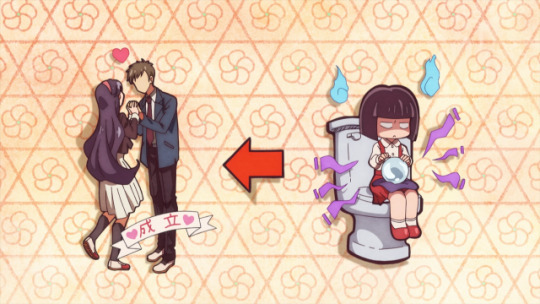
How to channel your ghost powers for success (Source: Funimation)
Hanako, because of her relatively modern backstory, is just as ubiquitous. Versions of Hanako appear in an episode of the 2018 Kitaro and most recently in the 2020 series Toilet Bound Hanako-kun. Tsunametsu currently edits the Folklore Society of Japan’s official academic journal, no doubt a testament to his priceless contributions to folklore representation in anime.
Who You Gonna Call?
There’s no way to tell the same ghost story twice. With such a layered history, contemporary anime have a nearly endless well of folkloric material to pull from. Recent series like the hit Demon Slayer: Kimetsu no Yaiba and Toilet Bound Hanako-kun prove that fans will never get enough of the supernatural, just as long as things stay fresh.
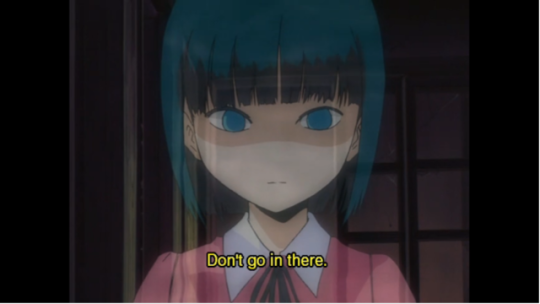
Hanako politely warns the ghost-hunting kids
Long live artistic liberty and specters trying to watch you pee.

Blake P. is a weekly columnist for Crunchyroll Features. His twitter is @_dispossessed. His bylines include Fanbyte, VRV, Unwinnable, and more. He'd like a tiny yōkai cat.
Do you love writing? Do you love anime? If you have an idea for a features story, pitch it to Crunchyroll Features!
By: Blake Planty
25 notes
·
View notes
Text
(Some) Greek Gods as Historical Figures
So some days ago I secretly logged back into Mythology and Cultures amino and I stumbled across post of casting historical figures as the gods from Greek mythology. Of course, I hated it, so I made my version of this.
Note: Of course, this is going to have quite a lot of Napoleonic figures, since I am more familiar of this period, but please do reblog this post (or tag me on another post) with the hashtag “#mythical figures as historical people” and add some more of your historical figure Greek God fancasts!
Note 2: this post is for entertaining purpose, and just me introducing some guys to y’all and I am not a historian myself and hopefully you all would still like my takes😅
1. Zeus - Louis XIV of France
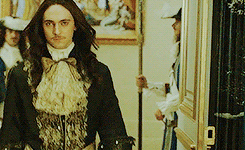
First and foremost, I shall introduce the king of gods featured in Greco-Roman myths. You may ask, why don’t I cast Henry VIII of England? Well, my reason is very simple: Henry is far from accurate to Zeus in actual myths.
To be honest, Zeus has a more “absolute power” energy in it, and Louis XIV totally has rocked it (like that iconic line “l’état, c’est moi (I am the state)”). Well, Henry also has that kind of energy but everyone only remembers his six wives and the uncountable number of bloodshed (not to mention Catherine of Aragon is a much better fighter than him—got this from Horrible Histories OwO)... Anyways, Louis XVI is basically a Zeus.
2. Hera - Catherine of Aragon

This brings to Catherine of Aragon herself. She’s a total Q U E E N and if you have watched “Six” the musical you already got what I mean (like, being the wife who married to Henry the longest). There’s also the early warlike aspect in Hera (featured in Homer’s works) that Catherine has it as well (at least you know that she’s getting more victories than Henry if you have watched Horrible Histories season 6, in the episode with Rowan Atkinson playing Henry VIII (which is sad because I want Ben Willbond to play him—he iconic to the HH fandom)), making her a great casting of Hera.
Hera, in my opinion, is a very strong woman who has to take Zeus’s shit and I could totally understand why she took revenge on the girls that Zeus has slept with—but anyways, hopefully you guys would like it :3
3. Aphrodite - Pauline Bonaparte

This is half-self-explanatory, really—just look at that statue she posed as Venus, the Roman equivalent of Aphrodite.
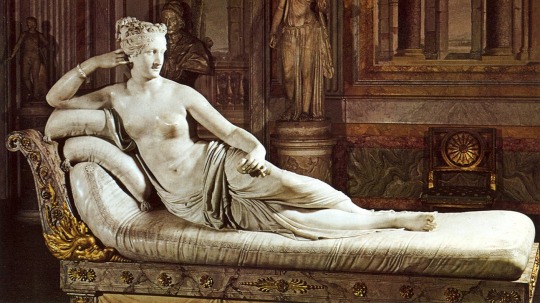
Pauline was famed for her beauty in her time, also a big chunk of scandals from her affairs (which bugs her big brother Napoleon, a lot). Nevertheless, despite her big spending habits and a great sexual appetite, she always helped Napoleon in some surprising ways (like she sold her house in Paris to the Duke of Wellington to get the funds for Napoleon).
Just like Aphrodite herself, Pauline harnessed her beauty very well. Thus, I rest my case.
4. Apollo - Joachim Murat or Emperor Franz Joseph I of Austria
(Warning: long content ahead)
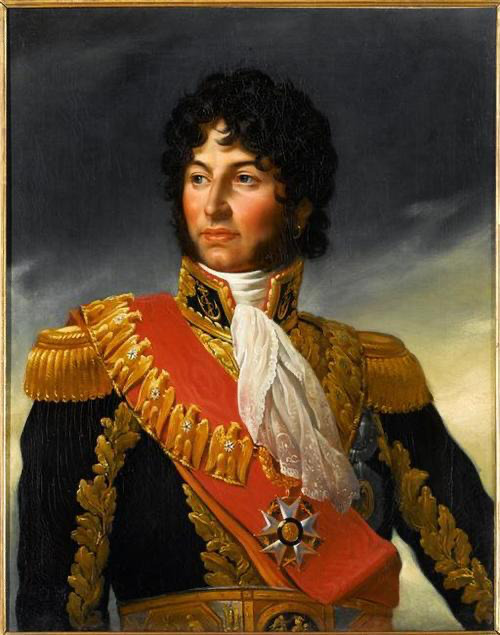

Firstly, let me briefly introduce them because you guys might not know them much.
Joachim Murat was a marshal of France, also one of Napoleon’s brother-in-law, grand duke of Berg and Cleves from 1806 to 1808 and the King of Naples from 1808 to 1815. After the wars, he attempted to escape yet was caught and executed in 1815 in Pizzo, Italy (if you have read of Alexandre Dumas’s “Famous Crimes” you might know him—by the way no one has cut his head off and sent it to that big nose King Ferdinand).
For those who have watched “Elisabeth” or the “Sissi” movies, you might know Franz Joseph I of Austria already but you might not know much about himself besides being the husband of the (in)famous Empress Sisi (ie. Empress Elisabeth of Austria). He was the Emperor of the Austria from 1848 to his death in 1916—one of the longest reigning European monarchs in history. During his reign, the empire had been through a lot of change, most notably, the creation of Austria-Hungary. Nevertheless, he was also the Emperor who started World War I and he died of old age in the midst of the Great War.
For Apollo, I’m not casting musicians because this is quite overdone. I rather want to shed a light to the other arts that he represented in Greco-Roman mythology. This makes me want to draw a parallel to Joachim Murat as he was also a great sucker of classical literature. Plus, he also was known to be a flamboyant dresser (his nickname was “the Dandy King” by the way), also the designer of the uniforms of the Neapolitan army (with an excessive amount of amaranth, perhaps his favourite colour). Really, everyone just sees him as a great flamboyant himbo but in reality, he’s iconically badass in the battlefield as the First Horseman of Europe. Well, also he’s known for being extremely good with women even though his wife Caroline was fierce as hell. So, in my opinion, he fits the image of Apollo that we know.
However, you guys might feel surprised why I picked Franz Joseph for Apollo. Well, he really... was a rather mediocre ruler in my opinion, and perhaps our most memorable image of him was the senile emperor who signed the declaration of war to Serbia. Nevertheless, he was a well-liked man among his subjects, at least to some old citizens of Austria-Hungary telling future generations. Besides, culture flourished in Vienna under his reign—with notable figures like Sigmund Freud, Ludwig Wittgenstein and Erwin Schrödinger. Despite the series of unfortunate events which made the empire started to crumble, Austria-Hungary arguably has its cultural importance in Europe. Sounds like what Apollo would do if he’s a ruler, somehow.
Well, enough of his political achievements, let’s talk about his private life... which was probably the actual reason why I picked him.
Enter Duchess Elisabeth in Bavaria, the Empress of Austria and Queen of Hungary, also known as Sisi.
On a side note, Marshal Louis-Alexandre Berthier of France, Prince of Neufchâtel and of Wargram, was Empress Sisi’s grand-uncle in-law via his marriage to Duchess Maria Elisabeth in Bavaria

Absolutely love Pia as Elisabeth in the musical so please don’t mind me using a gif from this :3 ((also, “Elisabeth” spoiler alert
Franz originally was to marry her sister Helene (nicknamed Néné), nevertheless, on the first meeting in Bad Ishl, he has fallen for the young Elisabeth, head over heels—making him defying his domineering mother, Archduchess Sophie, for the very first time. Elisabeth also liked him and did not expressed her refusal either, so they got married in St. Augustine’s Church in 29th April, 1854.
However, the marriage was not well. Sisi was not accustomed to the strict Austrian court especially Archduchess Sophie (also she was not really a fan of intimacy). Poor Franz was rather helpless in situations between his mother and his wife, and eventually, Sisi chose her freedom over her duty as Empress, traveling around the world. They two briefly went back together during the Austro-Hungarian compromise, yet she was constantly not there. Eventually, Sisi was assassinated by an anarchist named Luigi Lucheni during her stay in Geneva, Switzerland, and Franz was devastated over her death (“she will never know how much I love her”).
To Franz, he loved her so, but he really didn’t understand her needs. Even though he had countless mistresses and female companions in Vienna, he still missed his wife. I say, he was really unlucky when it comes to love. Like Apollo himself, he dated countless nymphs and humans, but a lot of his notable relationships did not have a good end. (Probably Cyrene was the most lucky one, yet she also has chosen to be left alone after mothering several children with Apollo.) For this, I picked Franz Joseph as Apollo.
5. Ares - Jean Lannes or Michel Ney
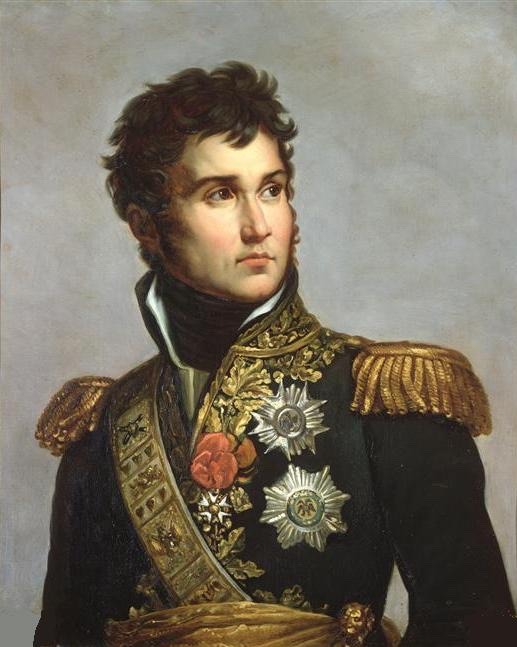

As usual, for those who don’t know much history, I shall briefly introduce my babeys these two great soldiers.
Jean Lannes was one of the marshals of Napoleon, known for being one of Napoleon’s closest friends and his fiery personality, and is considered one of the best marshals of the 1st French Empire. His finest moments including the Battle of Ratisbon in which he led his men to storm the well-guarded city with ladders (hence his nickname “ladder lord” in our very humble Napoleonic marshalate fandom :3). Sadly, he died of the wound he received in the battle of Aspern-Essling in 1809.
Michel Ney was also one of the marshals of Napoleon, known for his extreme valour (yep, he is known as the “Bravest of the Brave”). As you might know, he was one of the marshals who was in Waterloo, yet, his finest hour was during the retreat from Russia in the disasterous 1812. Sadly, he was arguably the most prominent victim of the White Terror under the second Bourbon restoration, executed in 1815 (**I am not accepting any kind of conspiracy theories of my babey survived and died in America😤).
Speaking of Ares, I have a lot of things to say (that’s my dad ;-; no jkjk). He is really not that bloodthirsty idiot who casually hates humans. Well, he’s more like a fiery dork and a man who was very faithful to his lovers, and fights very well (by the way also one of the best dads). So, the bois that come into my mind are automatically two of the most courageous marshals of France.
Lannes, if I have to get him a godly parent, it would definitely Ares. He resembled the god a lot (also I sometimes imagined Ares as a smol bean with dark hair), probably looks the most like Ares himself. He got that fiery temper, that faithfulness to his wife Louise, also being a very courageous fighter in the field—well he literally was like, “NO LEMME STORM DAT CITY *grabs ladder*”.
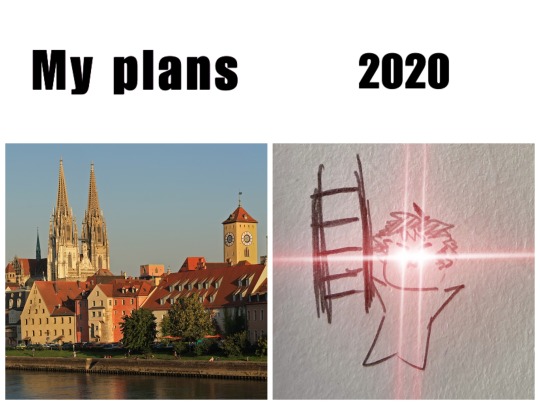
There you have it, my big bro our ladder lord Jean Lannes who can pull off a perfect Ares.
Ney is like a slightly introverted (and mature) version of an Ares person. You can guess his temper already through his famed auburn hair, and indeed despite his shy exterior his temper sometimes was a bit explosive, and a bit impatient (which was somehow one of his fatal flaws). He was a great fighter, known as a skilled swordsman in his youth. And you all know how brave he is in his famed epithet. Michel Ney is purely badass (and C U T E) you know (and he needs a lot of hugs because he has really been though a lot in the wars, and was a possible case of PTSD which was shown in his arguably suicidal behaviour during the battle of Waterloo). That’s why I casted him as the Greek god Ares OwO
//
And there you have it, my interpretations on the Greek gods via people in history. I originally would like to include more but somehow I realised that I have written too much about my picks. So, if you want to add more, reblog this post or tag me on the post you made on this topic (and please use the hashtag “mythical figures as historical people” so that I could look into your choices via the search bubble on this app🥺).
Last but not the least, I hope you all lovelies like this, also have learnt something new via my brief introductions on some historical people. Have a great day!
#greek mythology#finally some Greek mythology content#i hope you all don’t mind me overselling my bois#no shipping intended on the castings#this is from an ex-Hellenic devotee who had been in Classics class#Zeus#Hera#Aphrodite#Apollo#Ares#methods of procrastinating from university tasks and responsibilities#why am I still up in 2am I said I would get a proper sleep tonight for excessive headbanging to David Bowie for his birthday🌚#the relationship between Franz and Sisi got me sobbing all the time#Louis XIV#Catherine of Aragon#pauline bonaparte#joachim murat#franz joseph i#elisabeth of austria#elisabeth of bavaria#empress sisi#jean lannes#michel ney#mythical figures as historical people
93 notes
·
View notes
Text
So... this week has been very very bad for me, through nobody's fault but my own. I've been feeling completely miserable, worthless, and just overall unskilled, like everything I do pales in comparison to what my friends can do. Like if I wasn't around, there would be no impact. In fact, someone who's just me but more socially well-adjusted and talented would be in my place instead.
I have friends. Who are younger than me. Who draw way better than me. Who don't even want to do cartoons for a living.
And every time a friend would try to console me with "your stuff's good too!" it just felt like disingenuous pity. Like, there's a very clear quality gap between my stuff and my friends' stuff, it would be insulting to them to insinuate I'm as good as they are. And if I was as good as my friends, then why am I not getting as much traction on my high-effort stuff as they are? None of this is out of spite, I'm just justifying my own self-loathing.
And the only things I feel I do uniquely from them are my script writing (soon to no longer be unique) and voice acting (which I barely do professionally anyways). Neither of which can be accurately valued easily for the above reasons.
And this isn't just a hobby to me. Cartooning is my life- the thing that's always defined me and kept me happy. The worst years of my life are now far behind me, so why am I still so miserable? Am I purposely subconsciously preventing myself from just being happy?
But tonight in the middle of class, I remembered a line from a movie that I already liked, but finally clicked with me.
It was The Suicide Squad's "Rats are the lowliest and most despised of all creatures. If they have purpose... so do we all." Just that moment from the movie, seeing Ratcatcher 2 look up at Sebastian and his friends take down one of the most powerful beings in the universe with the help of her father's gifts, remembering his words, is so iconic. It's such a rare moment to see in cinema overall, just seeing Cleo remember how much she absolutely loved her father despite all his flaws, protecting and comforting Bloodsport despite all his flaws, as she smiles with fulfillment and love, so much love that she's absolutely unabashedly SOBBING from all of it.
And as I recalled that scene and the amazing music in it, feeling the wave of emotion well up, I realized was what about to happen and excused myself to go outside. Where for the first time in a year of having my emotions dulled from the pandemic, numerous recent rejections, life in general, and my own inferior psyche, I just started bawling too.
Because that's when I realized that yeah, even though I'm not that good at art, even if I don't ever improve to the level I want to be, I'll always still be able to contribute. I'll always have a purpose, even if I'm this too-old, twisted, awkward person who doesn't have a concrete identity, and had to go through years of therapy after being sent to a tiny island's tiny island to get pneumonia and almost die. Being told that my art is good enough when I know it's not didn't really help me at all. It was being told that I'm good enough even if my art is not that absolutely hit me in the right spot.
Because if someone told me that I should feel better because my art is actually good, that sort of implies that in the case or on the day it isn't, then I deserve to feel bad. But that scene made me realize that being bad at art doesn't mean I can't still make my friends happy, that I still can't inch closer to my dreams anyways, that I can still accept the little bits of love that come my way. (Now my trust issues however, are a whole other can of worms that I won't get into now)
And while I still wanna do a proper massive analysis of all the GOTG movies before the third film comes out, that line from The Suicide Squad matches up in how much it impacted me with other James Gunn written lines like "When you're ugly and someone loves you, you know they love you for who you are." and the following "Well, then I am certainly grateful to be ugly~!", as well as "I didn't ask to be torn apart and put back together over and over and over and turned into some... some little monster!!", and "Just a little bit of love reminds you how empty that hole inside you really is!" and just Kraglin's open tears of joy at Yondu getting honored by the other Ravagers.
A lot of people think depressed people need to hear "You're great! You're good at things! It will be okay!" when Gunn knows that what they really need to hear is "Even if you're not great, even if you're not good at things, it will be okay because you still deserve love no matter what."
While I have a comic coming out with the negative outlook from before, and while I may relapse after the small growth I had today, I'm really glad I could air out my feelings here.
#the suicide squad#the suicide squad spoilers#james gunn#guardians of the galaxy#q speaks#negativity#tw dysthemia#tw depression#ratcatcher 2#cleo cazo
13 notes
·
View notes
Text
Ele-May-ntary - Number 3
Welcome to Ele-May-ntary! All throughout the month of May, I’ve been counting down my Top 31 Favorite Portrayals of Sherlock Holmes, from movies, television, radio, and video games! We’ve reached the Top 3! The end draws ever nearer! And for those of you who have been wondering about this particularly well-known portrayal, the wait is over. Number 3 is…Basil Rathbone.
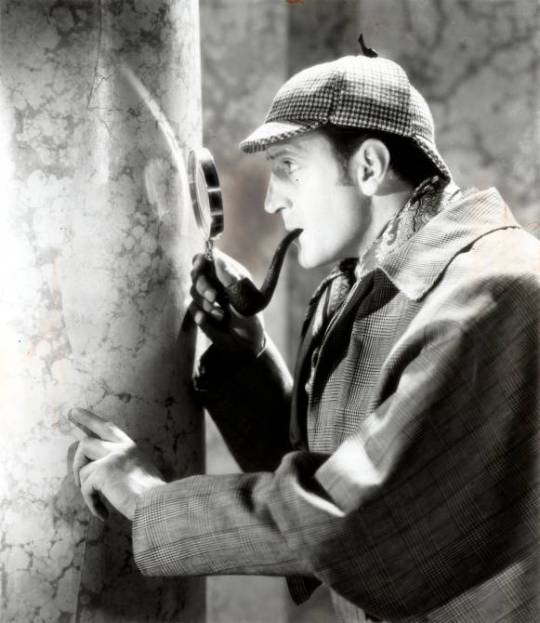
There have been many actors who people would call the definitive Sherlock Holmes. This interpretation may or may not be worthy of that specific title, but I think it’s very fair to say that Basil Rathbone is the most ICONIC Sherlock Holmes. So much of what we identify as Holmes today comes more from Rathbone than any other actor before or since. Even to this day, to tons and tons of people, Rathbone just IS Sherlock Holmes, much in the same way Bela Lugosi is Dracula or Boris Karloff is Frankenstein’s Monster. However accurate or inaccurate to the source material these portrayals may be, they’ve just become so synonymous with both the actor and the literary character that it’s hard to separate them. Part of Rathbone’s power as Holmes comes from his longevity in the role. He first played Holmes for two films produce by 20th Century FOX. These pictures – “The Hound of the Baskervilles” and “The Adventures of Sherlock Holmes” – were lavish period pieces. FOX lost the rights to Holmes (at the time, the character was not yet in the public domain, but still controlled by Sir Arthur Conan Doyle’s estate), and Universal picked up where they left off, creating twelve new films: fourteen movies in all, by the end of their twin runs. The Universal films – like so many screen treatments before – were set in contemporary times, simply due to budgetary issues. These movies were not the end of Rathbone’s tenure – nor that of his Watson, the incomparable Nigel Bruce: both of them played the roles for years on radio both in-between and after the films. These radio programs – a series called “The New Adventures of Sherlock Holmes” – were once again period dramas, since the theater of the mind allowed Holmes to return to his roots without much issue. The radio show lasted eleven years, starting in 1939 (incidentally, the year the “Adventures” film came out) and all the way into 1950…although it should be stated that Rathbone only stayed on till 1946, which was also the year his final Holmes picture, “Dressed to Kill,” came out. Even THIS would not be the end, however, for in later years, Rathbone would go on to play the character a handful of times onstage. “The only mystery I could not solve,” Rathbone once said, “Was the same one Conan Doyle had: how to get rid of the damned man!” While Rathbone may have eventually grown tired of his reputation as Holmes, it was one well-deserved. I often feel that, nowadays, people don’t have enough appreciation for his take on the character. Every time I see a documentary on the subject of Holmes throughout the ages, the people involved are quick to comment on how inaccurate to the source material things are, with the modern day settings and Bruce’s Watson, and often compare Holmes to James Bond…which…is apparently meant to be a NEGATIVE comparison? (I…don’t understand that…then again, after Roger Moore, maybe it makes more sense…) Personally, I’ve never understood this negative backlash, as Rathbone’s Holmes really does capture the character wonderfully. Beyond Sherlock, most of Rathbone’s characters were actually villains, and I think in a way that helps his Holmes out. While Holmes is a heroic figure, there’s something…reptilian about Rathbone’s performance. A sense of something uncanny just under the human skin, if that makes sense. He can be sympathetic and patient, but he can also be condescending and snarly. He has his moments of deep depression, just as he has his moments of energy and intensity. He’s got a sense of humor, and it’s not always clear if he’s mad or just crazy like a fox, with the many eccentric things he gets up to: from experimenting with houseflies to shooting bullet holes in his wall. He’s got his dramatic side – prone to grandiose speeches – and while he’s always right, he’s not always able to pick the best time to BE right. He actually does make mistakes here and there, often due to his own arrogance. Plus, he DOES have a dark side, and it’s tapped upon in a couple of films and radio episodes. He’s even implied to be partial to cocaine! That’s something that was hard to slip past censors of the time! On top of that, alongside Arthur Wontner, Rathbone arguably LOOKS the most like the character drawn by Sidney Paget…perhaps even more so, now that I think about it, simply due to him being closer to the age Doyle describes. Bottom line: sure, there were liberties taken with the material, but I would argue Holmes is actually pretty spot on in Rathbone’s hands. It was, perhaps, the first truly definitive portrayal of the character, and I even have to give credit to Nigel Bruce’s Watson, who is often maligned for his comedic performance. It was something other Watsons later tried to imitate, but not with the same level of success: they almost always felt like they were just “Diet Bruce,” while Bruce made the comedy work with a decent balance. He could certainly be a fool, but he DID help Holmes out, and the chemistry between Rathbone and his ally was absolutely perfect. You never once doubted it when Holmes claimed he needed Watson, no matter how many times Watson made himself look like a clown. Sometimes, it would be Watson who would provide a final solution to a puzzle, or at least an important piece, and sometimes we’d just get these wonderful moments where the strength of the relationship between the characters could shine. Bottom line: inaccurate or not, both these actors deserve a lot more credit than they get, and they remain legendary for a very good reason. They are most assuredly deserving of my Top 3. Tomorrow is the penultimate entry on the list. Who will it be? Check in and find out!
#ele-may-ntary#top 31 sherlock holmes portrayals#sherlock holmes#fox#20th century fox#universal#universal studios#rathbone-bruce series#new adventures of sherlock holmes#new adventures radio#radio#basil rathbone#number 3
24 notes
·
View notes